#also it was shot at television centre!!!
Text

summary. instead of spending two weeks in a hot country, you're stuck in a cramped hotel with your boyfriend.
wc. 1.3k
tags. richly!gojo au, fluff, slightly suggestive themes but not really you've got to squint hard, swearing once
series masterlist

“i’m literally dying,” gojo whined, falling back dramatically onto the double bed in the room.
you shot him a glare from where you sat on the floor, searching through your suitcase for ibuprofen which you had grabbed in the airport’s pharmacy to help with the searing headache you had. despite his tendency to have migraines that could leave him bedridden for days, gojo had decided not to bring any painkillers just in case and that was just one of many reasons you might be killing him before the fortnight is over. “if you complain one more time you will be dead.”
you were meant to be going on a two week, all inclusive holiday with your darling boyfriend and his mega rich family in a hot foreign country, the worries of college pushed far to the back of your mind for fourteen days of pure bliss.
but fate clearly didn’t think you’d earnt such restbite as upon arrival and taking the mandatory test, both you and gojo had tested positive for covid-19. the light sniffles he had put down to hayfever and the headache you’d assumed was just what came with having gojo satoru as a boyfriend, were in fact symptoms of the illness you both had.
so now here you were: isolating in a small hotel room until your isolation period was up, or you both tested negative. it was sparsely decorated – a double bed in the centre of the room and a television opposite. there was a small open wardrobe where gojo had dumped his suitcase and an ensuite that would just about fit your lanky boyfriend. although not the best, there was some air conditioning as well which made the stifling heat just a little bit more bearable.
the staff had given you a specific number to call if either of your symptoms got worse and food would be brought to you at specific times everyday (not like the usual room service gojo was used to where he’d order banquets of food at stupid times in the morning). there were also the morning tests that you now had to do daily which left you pathetically sneezing afterwards. all in all, nothing that you had expected for your get away.
after finally finding the medication, you quickly swallowed two pills down with a sip of water. the sooner they could kick in and actually do something to help ease your discomfort, the better.
crawling onto the double bed, gojo welcomed you with open arms and you gratefully curled into his side, throwing one of your legs over him. yes, it was boiling and yes, you were mildly irritated with your boyfriend, but you were also in pain and, for all his flaws (which he denied having any), nothing could top being held close by him. the two of you were clingy with each other at the best of times – being ill and feeling sorry for yourselves only made you both worse.
“pass me the remote,” you patted the space next to gojo blindly, too lazy to lift your head to actually search for it. it had now been almost an hour of you two cuddled up on the bed, and for the last thirty minutes gojo had been rewatching the same show over and over. whilst you headache had marginally subsided, listening to the same crappy show was only driving you insane.
“no, i like this show,” gojo whined, swatting your hand away.
“satoru,” you dragged out, muffled as you pressed your face further into his top, “you’ve watched this episode three times, you don’t need to watch it again.”
gojo hummed thoughtfully, running his hands through your hair. it was enough to make you fall asleep if you weren’t careful. “yes i do.”
“why?” you rested your chin on his chest, meeting the gaze of his bright blue eyes that sparkled as they looked down at you.
“because i’m ill.” he coughed twice for affect, sounding as pathetic as ever as he ‘checked’ himself for a fever too.
you narrowed your eyes at him before pinching his side, causing him to let out a small yelp. “who’s fault is that?”
“covid’s.”
“no. yours,” you said pointedly, a little more alert as you relayed all the reasons why it was in fact gojo’s fault that you both had contracted this illness. “i said don’t go to geto’s party, we’re about to go on a very expensive holiday. you said but baby please please please-” you huffed, rolling back onto your back next to him defiantly. “so i gave in, as per, and now we’re–”
gojo brought his other hand to messily pat the top of your head, coaxing you to turn to face him. “i love it when you’re mad,” he was wearing a shit-eating grin that only widened when you blankly stared back at him – your annoyance radiating off of you in waves more powerful than the ones you could’ve been enjoying on the sun-ridden beach. “you’re so sexy.”
“you’re corny. and annoying,” you sat yourself up as you held out your hand, lifting a finger with each complaint, “and stupidly tall, and a pain in my ass… and i feel like you’re not even listening.”
gojo crossed his arms behind his head as he condescendingly nodded along, gazing up at you with a lopsided smile. his top had risen up ever so slightly to expose a sliver of his abs and you hated how attractive he looked when all you wanted to do was throttle him for his childish behaviour.
“oh i’m listening baby,” he encouraged with a teasing tone, tracing small patterns on the exposed skin of your leg. “go on.” there was a fire in his wake, one that no hot weather could ever compare to, not even covid had this much of an affect on you.
“i don’t think i want to anymore,” you mumbled arms crossed as you slowly lay back down and avoided his eyes, trying not to give him any indication that you were a complete fool for his touch (like your sudden bashfulness wasn’t completely giving you away).
gojo was slow with his movements, thoughtful as he dragged his hand up along your thigh, grazing your hips, giving your waist a light squeeze as he traced the outline of your body. your breath was caught in your throat as you allowed him to do as he pleased, all previous grievances forgiven as you watched entranced. gradually, he closed the gap that you had created, shifting his body until he straddled you, holding his body up by resting on his forearms either side of your head.
gojo dipped his head down, lips milimetres from your own that you would barely even need to lift your head from the pillow to touch. his voice was an octave deeper as he spoke. “shame, i was just starting to–”
and then he fell into a fit of very loud and very barky and very not sexy coughs. he didn’t even give you the decency of trying to limit the spread of his germs and buried his head into the crook of your neck once his coughs were over.
“mood fucking ruined,” you hit his shoulder lightly and he babbled something that was completely muffled and only tickled as his lips brushed your skin. “please let me at least change the channel so i die from this illness and not insanity.”
gojo lifted his head up ever so slightly, just enough so that he could peck the corner of your lips and point to the spot next to you. “i slipped the remote under my pillow. tv’s all yours baby.”

a/n. I think this is like the first thing ive posted in almost a month. I MISS YOU GUYS xxx
taglist. @jar-03 @animeflower26 @hyori2
#— toru!!#satoru#gojo drabbles#gojo x reader#gojo#gojo satoru#gojou satoru x you#gojo fluff#gojou satoru#rich boy!gojo
717 notes
·
View notes
Text
Video 📹 from Instagram
PICS: STARS STEP OUT IN STYLE FOR THE 2024 IFTA FILM & DRAMA AWARDS

The 2024 IFTA Film & Drama Awards attracted a star-studded list of guests on Saturday night – including Oscar winner Cillian Murphy, James Bond legend Pierce Brosnan and Oscar nominated actress Lily Gladstone.
The 21st Anniversary awards show is taking place at the Dublin Royal Convention Centre, hosted for the first time by Emmy-winning broadcaster Baz Ashmawy.
A host of famous faces will be awarded by the Irish Film & Television Academy across 28 categories in Film and Drama at the ceremony.
Check out the red carpet arrivals below as the biggest night in Irish film kicks off in style:

Lily Gladstone pictured at the IFTA Awards 2024 at the Dublin Royal Convention Centre. Picture: Brian McEvoy

Cathy Belton pictured at the IFTA Awards 2024 at the Dublin Royal Convention Centre. Picture: Brian McEvoy
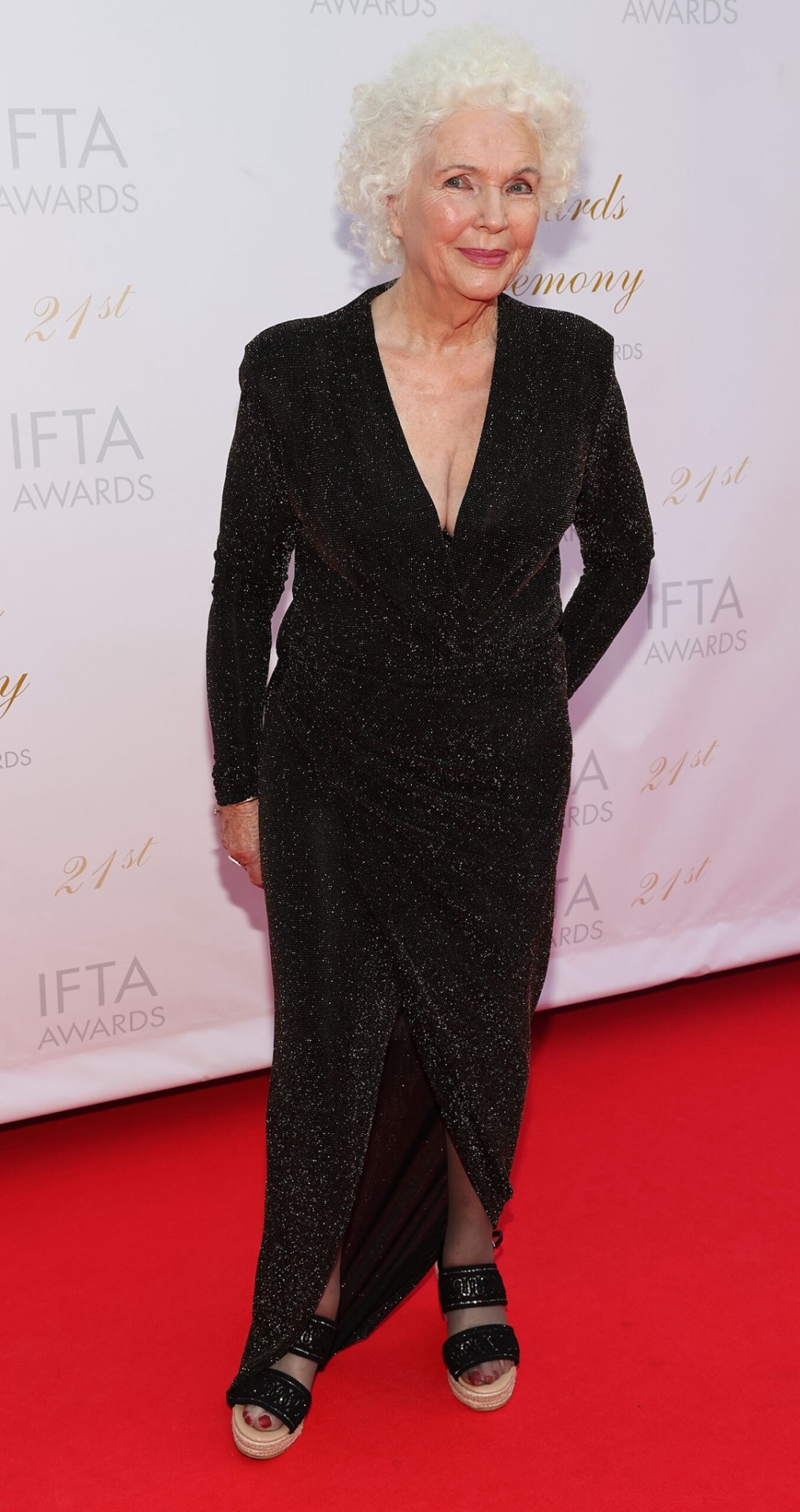
Fionnula Flanagan pictured at the IFTA Awards 2024 at the Dublin Royal Convention Centre. Picture: Brian McEvoy

Clare Dunne pictured at the IFTA Awards 2024 at the Dublin Royal Convention Centre. Picture: Brian McEvoy

Caitríona Balfe pictured at the IFTA Awards 2024 at the Dublin Royal Convention Centre. Picture: Brian McEvoy

Niamh Algar pictured at the IFTA Awards 2024 at the Dublin Royal Convention Centre. Picture: Brian McEvoy

Alisha Weir pictured at the IFTA Awards 2024 at the Dublin Royal Convention Centre. Picture: Brian McEvoy

Baz Ashmawy pictured at the IFTA Awards 2024 at the Dublin Royal Convention Centre. Picture: Brian McEvoy

Stephen Rae pictured at the IFTA Awards 2024 at the Dublin Royal Convention Centre. Picture: Brian McEvoy
Stephen Rea will also receive the coveted Lifetime Achievement award.
Ahead of the awards show, celebrity attendees stepped out in style on the red carpet – including Eve Hewson, Sharon Horgan, Caitríona Balfe, Kerry Condon, Liam Cunningham, Clare Dunne, Niamh Algar, Emmett J. Scanlan, and Alisha Weir, to name a few.
The highlights of the IFTA Awards ceremony will be broadcast on RTÉ2 on Monday, April 22nd, at 9:35pm.
Goss
Note: The story also includes photos of James Patrice, Pollyanna McIntosh and Liam Cunningham, abd Emmet Scanlan with his daughter Kayla.
Remember the red carpet shots?
#Tait rhymes with hat#Good times#Outlander#Awards#Irish Film & Television Academy#IFTA#20th#21st Anniversary#IFTA Awards#Host#Baz Ashmawy#Red Carpet#TikTok#Hosts#Eric Roberts#India Sasha#Royal Convention Centre#20 April 2024#Dublin#Campaign To Shorten Awards Season#Thanks sunsetmagic85#Thanks thetruthwilloutsworld#Instagram#My screenrecording
24 notes
·
View notes
Text
Just over a year ago, a woman told a crowded room that her ex-husband had kicked and slapped her. She described him throwing a phone at her face. She described him penetrating her with a wine bottle. “I remember not wanting to move because I didn’t know if it was broken,” she said. “I didn’t know if the bottle that he had inside me was broken.” While she said all these things, people laughed. People called her a whore and a liar. People cheered for her ex-husband, and made posters and T-shirts emblazoned with his face.
Only about 14 months have passed since Amber Heard was mocked and shamed on a global stage. But, apparently, that means it’s now high time to relive it. This week, a new three-part series from director Emma Cooper drops on Netflix (UK viewers can also watch via Channel 4 on demand). That’s right folks, we’re back in the hellscape that is Depp v Heard.
There are certain legal cases that transcend courtroom drama to become full-blown ‘where were you when’ cultural moments. Usually, these ‘trials of the century’ are criminal trials. Charles Manson in 1970; OJ Simpson in 1995. But, occasionally, a different calibre of case will grip the public consciousness – one that spins around sex and humiliation; one that strikes to the heart of how contemporary culture understands gender and power. In 1991, attorney Anita Hill testified that Supreme Court nominee Clarence Thomas had sexually harassed her while she worked as an adviser to him. The Senate ultimately confirmed Thomas’ nomination, while Hill received death threats. Just a few years later, as the new millennium swam into view, another sex scandal rocked American society. This time, the main characters were President Bill Clinton and Monica Lewinsky. Despite Clinton eventually admitting to having had an affair with Lewinsky, for many years the court of public opinion was clear in its verdict: Monica Lewinsky was either a whore, or a liar, or both.
In a sense, the Johnny Depp and Amber Heard defamation trial, which took place from April 11 to June 1 2022, in Fairfax County, Virginia, combined elements of all of these previous ‘trials of the century’. As with Clinton and Lewinsky, a relationship between a younger woman and an older, more famous and more powerful man was under the microscope. In an echo of Hill v Thomas, during which lawmakers accused Anita Hill of suffering from a ‘delusional disorder’, a psychologist hired by Depp’s legal team ‘diagnosed’ Heard with borderline personality disorder and histrionic personality disorder. Like Charles Manson, the man at the centre of proceedings was also the figurehead of an obsessive fan club. And if that fan club grew to resemble a cult, in its slavish devotion to Depp against all reason, it’s largely because, like Simpson’s trial, the whole thing was televised.
However, one key difference between Depp v Heard and these other previous high-profile trials, is the influence of social media on public opinion. The trial was not only ‘televised’ but also TikToked, live-streamed and memed. The tagline for Cooper’s three-parter Depp v Heard even bills the trial as ‘the first trial by TikTok’.
The show opens with the Hollywood sign flickering into Amber Heard’s face on a red carpet. There’s old footage of Depp and Heard on the Hollywood walk of fame, at a dinner, and stepping off a boat in Venice glitch and distort into shots of Los Angeles freeways. News anchors read headlines about the couple, and about the trial. The screen glitches again, into a tree lined highway in Virginia. More clipped footage, more contextualising news clips. Then one anchor raises an important issue – a crucial factor in the trial proceedings that, a year on, often gets lost in the heady internet fog of misinformation, conspiracy, clout-chasing and PR campaigns. Why was the whole sorry spectacle staged in Virginia, when neither Heard nor Depp live or work there?
Well, the ‘official’ reason Depp was allowed to sue in the state is because the news outlet that ran Heard’s article, The Washington Post, “houses its printing press and online server in Fairfax County.” Yet, it’s also because, under Virginia law, the trial judge can decide whether to allow cameras in the courtroom.
Heard’s team tried to exclude the cameras from the trial. At a pre-trial hearing in February, attorney Elaine Bredehoft noted there was already a huge amount of media attention on the trial, as well as scrutiny from what she described as “fearful anti-Amber networks”. “What they’ll do is take anything that’s unfavourable,” Bredehoft said, “they’ll take out of context a statement, and play it over and over and over and over again.” Depp’s team, on the other hand, wanted the trial televised. “Mr. Depp believes in transparency,” his lawyer, Ben Chew declared. It should have been a sign of what was to come that the judge sided with Depp. “I don’t see any good cause not to do it,” Penney Azcarate, the chief judge of Fairfax County, announced. Others saw it differently. “Allowing this trial to be televised is the single worst decision I can think of in the context of intimate partner violence and sexual violence in recent history,” Michele Dauber, a professor at Stanford Law School said in May 2022. “It has ramifications way beyond this case.”
One of the ramifications of Judge Azcarate’s decision is that Depp v Heard is now on our screens. But, none of those quotes from various legal professionals are taken from the series. Indeed, there are no expert voices at all. There is no narration. No one who was involved in the trial is involved in this directly. There is no ‘broad view’, or ‘behind the scenes’, or ‘recontextualising with the benefit of hindsight’. This is a documentary in the loosest of senses. Early takes from the other side of the pond have been split – some critics have suggested it “casts the trial of the decade in a new light”, while others have deemed it “nothing more than a tactless win for pro-Johnny fans”. Perhaps this shouldn’t come as a surprise, given that the trial itself was so notoriously divisive. Personally, I’m inclined to agree with Audra Heinrichs of Jezebel, who described the docuseries as playing “like a highlight reel from hell”.
If Depp v Heard suggests anything, it’s that people consuming the trial were biased. Well, that’s hardly a scoop, and to my mind, it’s certainly not worth the full, three-hour docuseries treatment. The series doesn’t dig into the motivations of the anti-Amber content creators or their backgrounds. For example, one prolific poster and top Depp stan who is featured extensively but anonymously in Cooper’s three-parter is Andy Signore. Not long before the Depp v Heard trial began, Signore had been fired from Screen Junkies, the YouTube-focused company he founded, for a variety of sexual misconduct allegations. Having set up his channel Popcorned Planet after being dismissed, Signore now posts livestreams about ‘daily news’ and ‘pop culture justice.’ Mainly, he covers what he characterises as the injustice of the #MeToo movement. Signore more than doubled the following of his YouTube channel during Depp v Heard. He made more than 300 videos about the trial, ratcheting up millions of views as he built a new reputation as a crusader for ‘justice’ and, crucially, making money in the process.
All the content creators immortalised in this series, and many more besides, were making money – but this also isn’t discussed or made explicit in Depp v Heard. Cooper presumably believes this allows the content to speak for itself, and lets the viewer weigh up their own thoughts, becoming another member of the public jury. But the true effect is just blur – an endless stream of stuff. Just how much money were all these #JusticeForJohnny content creators making? Was there a coordinated and well funded online PR campaign for Depp throughout the trial, fuelled by bots, as many alleged post-trial? Depp v Heard has no answers, just more clips. He said, she said. No thoughts, just vibes.
I wrote about Depp v Heard last year as the trial was ongoing. Then, I felt like I had to maintain some semblance of neutrality in my discussion of the ‘facts’ of the case itself. The piece wasn’t about who was ‘right’, or who was telling ‘the truth’ – it was about how strange the spectacle of the case had become, and how dangerous a precedent it seemed to set, if trials about intimate partner violence could be spun into comic TikTok clips. I didn’t want to come down on one ‘side’. I wrote that “treating an ongoing defamation trial, featuring graphic and distressing testimony about physical violence, coercive control, and sexual assault, like […] Netflix’s latest true crime documentary series is, at best, distasteful and, at worst, actively dangerous.” Now, as Netflix’s latest documentary series opens up the can of worms again, the only true takeaway is how little we’ve learnt since then.
66 notes
·
View notes
Text
33... and you... and me
It's day 2 of @taznovembercelebration and today's prompt was "promise". I drew a second card and got "celebrity AU" so here's a mix of those. It's extra silly because what is taznc for if not to roll around in the ridiculousness?
You can find yesterday's here, and read this one below or on Ao3.
--
"I can't just slide into his dms and propose, you're being ridiculous." Kravitz flops back on the sofa, head in Sloane's lap. "Why'd he have to go and get famous and unobtainable?"
"Ah yes, it would be ridiculous, wouldn't it, for someone to get all famous without warning. Perhaps be some big shot that everyone wants as musical director."
Kravitz harrumphs. "I'm a big name to a very small group of people. It's not the same and you know it. Taako's on TV! Television!! He has live events! He signs things!! He has calendars, every year!!"
"You could have calendars every year if you just listened to my suggestio..."
"Sloane! I am not doing suggestive poses in my pants holding a baton. We've had this conversation an upsetting amount of times."
"Look Krav, I'm gay as hell, but I know excellent marketing when I think of it."
"Uh huh."
"But mostly, I know an excellent distraction when I think of one."
Kravitz is tumbling to the ground before he can do anything to counteract Sloane's shove. She's into the bathroom and has the door locked before he's back on his feet. Maybe he does need to take up yoga or something to help him fall and un-fall more gracefully.
"What’s going on?" Kravitz shouts through the door.
"I'm going through a tunnel, I can't hear you!" Sloane yells back.
"If you're ill you could have just said, do you need me to get you anything?"
"You can't be nice to me right now." Sloane has just enough guilt in her tone to indicate that this was, in fact, not a medical emergency.
"Sloane? What did you do?"
"What am I doING?" Sloane corrects.
"Sloane?" Kravitz tries not to let worry creep into his voice, he fails. Wait... No. No no no! Kravitz pats at his right pocket desperately, then the left just in case he stashed his phone there instead. Nothing. "Tell me you didn't?"
"What's that? Bad line, I can't hear you."
"Sloane!" The panic is there now, evident, front and centre, 100% justified.
There's no reply. Shit. Kravitz runs for his laptop, maybe if he just changes his password...
"I already changed it." Sloane hollers from the bedroom.
Kravitz changes tactic, tries for his emails.
"Sorry Krav, I changed that too."
"You don't even know what I'm doing."
"You're on your emails, you're predicable."
"Actually, I'm calling the police." Kravitz yells, petulant and stupid.
He can hear Sloane snorting with laughter from down the hall. She's never going to let him forget that one. Shit.
--
"How bad was the message you sent?"
“The message I sent? Oh, we’re not going to be talking about any messages from me today.”
“What do you mean?”
"Well, while rhapsodising about how much you want to marry Taako, how wonderful you think Taako is, how unobtainable and perfect and wonderful, you forgot to mention that you've stayed in touch. You also forgot to mention that he follows you. You forgot to mention, Kravitz, that you and Taako have been chatting."
"It's not chatting, it's just talking sometimes."
"Uh huh." Sloane narrows her eyes.
"He doesn't know who I am or anything. He probably doesn't even remember me."
Sloane clears her throat and reads off her screen. ""Nice to see that Taako's future husband is keeping it tight." Reply to a photo you sent him in which you're conducting. He does seem to have circled your arse in the screen shot he sent back."
"That's not serious. He's joking."
"And the countdown?"
"What?" Surely she didn't go through the whole conversation? There’s loads of it. So what if Taako messages him sometimes, so they video called semi-occasionally? It didn't mean anything, he'd never specifically said it meant anything.
"And I quote." Kravitz didn't like the sound of that. "Happy birthday, wandsome, 4 years 'til you're mine."
"That's... It… It doesn’t…"
"3 years 'til we can buy the cottage and run away together, handsome. Temporarily, obvi, Taako needs to stay current."
"How many screenshots do you have?" Kravitz might be able to anticipate exactly how bad this is if he knows. Maybe she searched for keywords and didn’t scroll.
"Your birthday last year: "1 year, we're nearly there, don't go falling in love with anyone else.""
"Okay, I get it. He talks to me and he remembers my birthday."
"Kravitz, you are, as ever, focusing on the wrong headline here. He remembers the promise, you know, the one you've been agonising over? Positively fretting about, in fact. "Should I remind him? Should I see if he's interested?" The answer's yes, Krav, you should see if the man who has reminded you about the ridiculous fucking promise for the last 3 years is interested in following through."
"But his boyfriend?"
"Hold on, wait, what boyfriend? Have you been messaging him even though he's with someone else?? Kravitz!"
"He's never mentioned him to me. Just, there's been a few interviews..." He tails off.
Sloane taps at her phone.
"Are you googling Taako?"
"No, I'm googling "boyfriend "Taako Tacco"" because I actually want relevant results."
Kravitz sighs and takes his place at Sloane's shoulder. Their height difference was nothing if not perfect for group research.
"My boyfriend doesn't like to be in the spotlight, we'll, apart from when he's doing it for work, he's a baller music guy, only the best for Taako, natch."
Sloane turned slowly to glance at Kravitz.
"I don't know who it is." He shrugs. "Taako didn't mention him to me, so I thought maybe it was to keep them off his back, or, you know, some kind of stunt."
"Mmm hmm. Well here's one from earlier this year, see if you can think of anyone it might be. Taako says: "I think it's pretty serious. We talked about marriage a long time ago and we check in every year. Mind you, who wouldn't want to be married to America's favourite kitchen wizard?""
"He's not wrong. Anyone would jump at the chance." Maybe his voice isn't meant to sound so dreamy, but it's Taako. He's everything Kravitz wants from a partner, funny, attentive, generous, smart, gorgeous.
Sloane all but groans. "Gross." She grimaces up at Kravitz. "Being disgusting isn't getting you out of this though, next one: "yeah, I'm sure he's the one. I've known him forever and haven't been interested in anyone else." Oh, and here’s some more, interesting: "he comes to my shows occasionally, I love it when he's in the audience, always inspires a bit of extra magic, gotta make sure he remembers how great Taako is." Haven't you been to a few of his shows, Kravitz?"
"Well obviously, I go whenever I can." He does, it's important to support your friend who you may also be in love with. It’s also really nice when Taako comps his ticket, although they agreed to do one on one off so Kravitz can support the show too.
"And you let him know you're going?"
"Well it usually comes up when we're chatting, or, you know, planning when to meet up?"
"Oh, so you've been meeting up?"
"Yeah, of course.” Kravitz hesitates. “...Only when he's in town and, you know, the times I flew out to meet him."
"Uh huh." Sloane's doing the voice she usually adopts when Kravitz is being particularly dim about something.
"It's nice, you know, to keep in touch."
"Would you say you keep in touch a normal amount, based on your other acquaintances?" There's a trap here, Kravitz can tell, but he doesn't know what it is.
"Well I talk to him less than you, and you're basically my only other friend."
"Oh don't make it sad when I'm trying to bully you."
"Sorry." Kravitz says, resting his chin on her shoulder, that might garner enough sympathy to get him out of this.
"So how often would you say you kiss, you know, when you're seeing each other a normal amount?"
Or maybe it wouldn’t get him of out this. Kravitz tries hard not to freeze up and demonstrate the level of panic flowing through him. "Ah… well, you know... The, er, the usual amount." He says, casually. Definitely casually. She won't suspect anything.
"Which issssss?"
Shit. Well, honest is the best policy. “Every time. Obviously. Kiss your homies."
"We're homies, we don't kiss."
"Would you, er... Like to?" Kravitz's throat is dry, clicking as he tries to get the words out. He really doesn’t want to have to kiss Sloane.
Sloane lurches away from him. “No! Gross. God.”
“Alright, there’s no need to be so totally disgusted about it.” He doesn’t need to be defensive about this, he doesn’t want to be defensive about this! He had one misguided attempt at kissing girls and realised very quickly that he had no interest in it, but, pride is a fickle thing, and Kravitz clearly needs to work on his.
“Are you actually upset that I, a gay woman, don’t want to kiss you, a gay man, who has absolutely no interest in me and knows that I don’t want any kind of romantic relationship with him? Also, what exactly do you think Hurley’s going to say when I tell her about this?”
“No! But…”
“Kravitz, you are very handsome, I will not stroke your ego any more than that. Back on track - you’ve been kissing Taako on the reg for at least 3 years now?”
Kravitz cringes.
“Kravitz!”
If he doesn’t reply he can’t be in trouble. That’s science.
“Kravitz AdventureZone! How long?”
“Six years.” He mumbles as quietly as he dares.
“One more time there, friend?”
“Six years.” He says more clearly, he’s not going to repeat it again.
“Six fucking years? I thought you were going out of town for work stuff!”
“I was sometimes! You didn’t ask every time.”
“I…” Sloane gives an exasperated sigh.
“Please tell me you know who his boyfriend is.”
“I just told you, Taako’s never mentioned him, I don’t know if he exists.”
“Kravitz. Engage your brain. Think about this. You have been seeing this man regularly kissing and I assume more…”
“I read about brojobs one time and just kind of assumed it was an extension of tha…”
“No, stop talking right now immediately. I refuse to hear you say anything else about boning down. You have never seen a penis before, even your own.” Sloane clamps a hand across his mouth. “Now, you’ve been seeing him regularly, kissing, more.” Sloane presses her hand down more firmly, just in case he tries to add anything else. “... and you work in music.” She removes her hand.
“I work in music.” Kravitz says quietly.
“You sure do.”
“And we message nearly every day, and video call a few times a week.”
“Uh huh.”
“And he sends me nice things and I send him nice things.”
“Yep.”
“And we joke about the promise every year.”
“Do you think maybe it’s not a joke?”
“He could have anyone!”
“I’m not convinced he wants anyone else, Krav.”
“I… I’m dating Taako?”
“Sure are, bud.”
“I. Fuck.” Kravitz sits down on the floor. “He never said.” He says, more to his feet than to Sloane. His Mums always taught him to put his head between his bent knees when he felt floaty so he could be small and heavy instead.
“Apart from all the times you talked about getting married?”
“He didn’t specify he wasn’t joking.”
“Did he specify that he was?”
“No.” Kravitz says, sulkily.
“And how about all the times you talked about moving in together?”
“We moved in together!” There, he’s being reasonable! Flawless logic.
“Yeah, but you’re not in love with me are you?”
“No.” Says Kravitz reluctant to admit defeat... Although, actually, wait. “But he doesn’t know that!”
“That you’re not in love with me?”
“No! That I’m in love with him.”
“So you haven’t told him you love him?”
“Well, I mean, I obviously tell him I love him.”
“Uh huh.” Sloane sounds like she’s about to implode.
“But like, in the normal way.”
“Uh huh.” He’s not sure he’s ever heard her voice pitched so high. “When you say normal?”
“Just like, the usual amount, that I would tell a friend who I’m in love with and also sleeping with and seeing regularly and… fuck.”
“Yes, you already established the fucking, there’s no need to boast.”
Kravitz should laugh, it’s funny, is the thing, it really is, but right now he’s rehashing 6 years worth of memories. It seems obvious, now that Sloane has laid it out for him, but how was he supposed to know? If no one clarifies then why’s he suddenly supposed to assume they’re dating and not just friends? At what point does that even happen? It’s been wonderful, is the thing, he loves that man, deeply, truly, passionately. That was the reason he’d brought up the promise in the first place. When they both hit 33, if there was no one else they wanted to marry, they’d marry each other. It had been the perfect plan when they were 10, and 15, and 20. But Taako had gone off and been famous and they saw each other less and Kravitz had just assumed that now that the world loved Taako too Taako would love someone else.
But he didn’t.
He hadn’t for the past who knows how many years, he definitely hadn’t for the last 6, because he’d picked Kravitz, chosen him to pour his time and his love into and Kravitz hadn’t even noticed properly. Or, of course he’d noticed that it was an important relationship. He’d celebrated Taako’s achievements, birthdays, candlenights; he’d bought every single one of his calendars and made him autograph them; he even made the world’s first and only copy of ‘“Got Wood?” a conductor pin up calendar’ for Taako. But no one had explicitly said they were dating. Taako hadn’t acknowledged it, well, except in the interviews… shit.
Kravitz stood up too fast, grabbed the table to steady himself. “I need to buy a ring.”
“Right now?”
“Right now! It’s nearly my birthday.”
“The promise?”
“Yes. I intend to keep it.”
-
Want to read more? Find Day 3 here.
#Sometimes it's tricky to know what's a relationship and what isn't#If everyone could just say the exact thing they mean and be really clear about it that would be great actually#Taakitz#Kravitz and Sloane are best friends and I'll hear no different#Kravitz#TAZb#TAZ Balance#TAZ fic#The Adventure Zone#Noodyl Writes#TAZnc#TAZ November Celebration
46 notes
·
View notes
Text
A Study In Style
Roll With It is the best piece of television ever put to screen. This is not up for debate, I will not be taking argument. I will die on this hill. Roll With It is perfect. No, I'm not biased.
In all seriousness, this episode is gimmicky and fun, so as far as plot goes, analysis is difficult. Instead, I'd like to focus on the character writing and artistic embellishments on display and explore what they do for the story.
Let me explain.
SPOILERS AHEAD: (She-Ra and the Princesses of Power, Spider Man: Into The Spiderverse, Arcane, Critical Role Campaign 3)

Artistic style is a remarkably underrated part of animation. People credit the writing and the direction, but the specific visual elements that make up a style can often have a more significant impact on the story.
Think of it this way. You are watching a series through a window. The direction dictates where the window sits and what it sees, the writing and the acting dictate what goes on outside, but if the style describes the window itself. A window made from tinted, stained, or warped glass will change what you see dramatically.

So, She-Ra's base art style relies on pastel colours and a two dimensional, cartoony aesthetic. It's realistic in theory, at least in contrast to One Piece, but its flat and appealing, and the expressions are often exaggerated to great effect.
Because focusing a shot is difficult when you don't have a camera (smudging colours in animation has a habit of not looking too good), animation has picked up tricks to focus the viewer's eyes. For example, Spider Man: Into The Spiderverse brought animation into the forefront of the public consciousness, and almost single handedly changed the industry, and it used a mixture of techniques to express its focus.

The items in the background of this shot are less detailed than Peter, and have a kind of 3D glasses effect making them difficult to focus on. They are also in stark contrast with the red of the Spidey Suit.
She-Ra takes a different approach, saturation. The vast majority of the series is shot in pastel colours with little-to-no shadows clogging up the shots. This is then accentuated by specific key-frames of bold colouration and deep shadows that contrast wildly with each other and the rest of the episodes they are in. I have a habit of using these key frames as my opening screenshot for these posts because I think they look the coolest.

The point of this is to highlight certain elements in your mind, in the same way that when you close your eyes after looking at a fire, the image lingers for a moment, memory tends to work the same way to bold colours. There is also the idea that making specific moments stand out visually tells the audience to pay attention.
If you focus on certain moments, you guide the audience's view towards them. It's the same thing that a camera does in a still image, focusing on specific items in the shot to guide the eye.

In Roll With It, as the characters present their own plans, the art style changes, to match the minds that you are being transported into. Adora's style is the same as normal for the series, but the contents are different. Adora is matter of fact and to the point, but she perceives threats everywhere. Adora cannot relax.
But the specific colour choice also has an effect on the meaning of a shot, and for that, let's discuss the other animated pioneer of the past few years, Arcane.

Arcane has zero chill, and even less subtlety. This shot centres around Jinx's mental instability caused by her sister. Its a tortured mind who is hallucinating about someone who isn't actually in the scene. So, naturally, her world is on fire with pink flames, associating that fire with Vi, for whom pink is a signature colour.

Glimmer, however, takes the series' key frames and colour and dials that up to eleven. Everything in this shot is bold and action packed. I am tempted to describe it as violently pink.
But the shot is entirely monochrome. Everything here is pink or black, and that acts as a neat worldview for Glimmer's worldview. Glimmer perceives the world in black and white, but where the white would usually represent good in that idea, here, it is replaced by pink, and by Glimmer. Adora has a reputation for a hero complex, but I would argue that Glimmer has something similar. Not in the same way as Adora's pathologic need to save people, but Glimmer definitely has an ego problem.
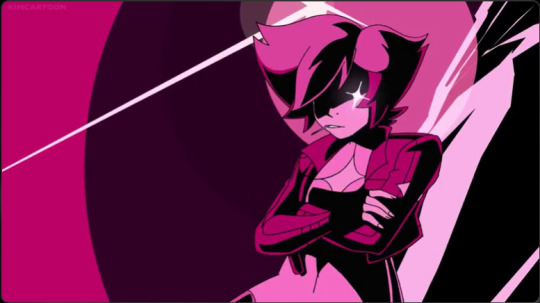
The pink also makes Glimmers mind difficult to read as an audience, and I think that is the point. Everything in Glimmer's worldview is super bold and in focus, meaning that it dims the effect of the focus. In the wise words of someone with a definite hero syndrome.
"When everyone's super, no-one is."
Glimmer is the perfect example of how someone with an incredibly simple worldview of good and bad can do some truly morally grey acts. In this case, because she doesn't believe in good and evil, she believes in Glimmer and evil. Either you agree with her, or you are her enemy. I wonder if that will ever come up again.
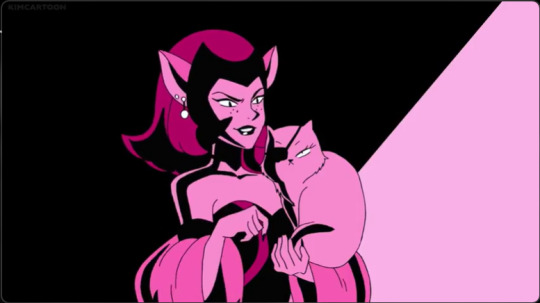
There's also no way I can mention this scene without pointing out that this is a reference top classic James Bond, and that speaks to Glimmer's character as well.
The original James Bond was a character whom the world revolved around, and who rarely ever failed. He was charming, and witty, and cool. In short, Glimmer perceives herself as a Mary Sue. And it's important to understand that this is her opinion of herself, and not the actual reality. Once again, Glimmer has an inflated sense of superiority and does not understand the fact that she could be flawed.
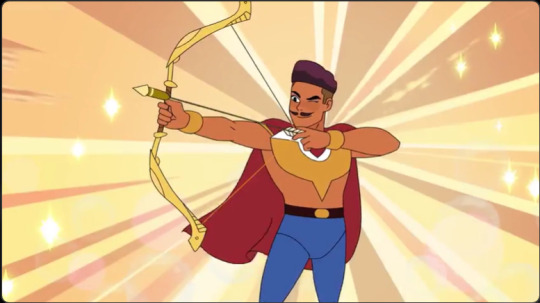
Bow, on the other hand, is simple. He is the single most simple character of the entire cast. But that doesn't mean he is flat. I want to stress that Bow is only rendered this way by the insanity of everyone else on screen.
In a world where everyone is a ticking time bomb, Bow serves to balance out the shenaniganry, which makes him an Orym figure.
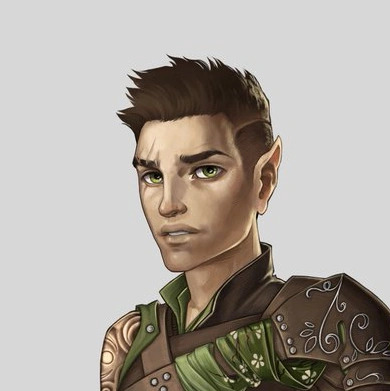
Art by Hanna Friederichs (@agarthanguide)
For context, Roll With It is very clearly drawing on the aesthetics of table top role playing games. This is the D&D episode, and no this hasn't artificially inflated what I think of the episode at all.
Critical Role is a D&D actual play series that is currently in its third campaign. If you have read my series on Stray Gods, you will recognise two of the cast members of CR as Laura Baily (Who played Grace) and Ashley Johnson (Who played Calliope).
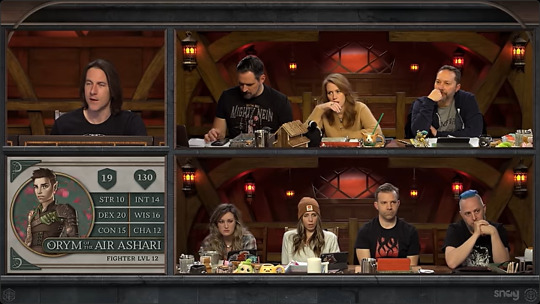
Orym of the Air Ashari is a character played by Liam O'Brien, a voice actor who is somehow not weighed down by the sheer amount of talent he is lugging around. Seriously, this guy has been in everything from Star Wars to League Of Legends.
In any case, the current campaign of CR centres around a collection of walking disasters, and I mean that as a compliment. Everyone in the series is one step away from spiraling into insanity, with the one possible exception of Orym.
So, Orym has taken the role of the team's everyman, rendered simple by the rest of the cast, and you can see where I am going here.

Bow and Orym are the straight men of the group (a deliberately ironic choice of wording), balancing out their companions and offering a sense of stability and comfort.
But, both Orym and Bow have stuff going on behind their eyes. Orym is grieving form the loss of his husband and father, and Bow is dealing with some serious self-worth issues, but you don't see those elements that often, purely because of the more overt nature of those they surround themselves with.
But this is a post about style, and what do the visuals of Bow's plan tell us about him?

Well, Bow's style draws on the aesthetics of the original She-Ra series, back when the series was designed entirely to sell toys and nothing else.
Once again, Bow is simple, he is a paragon hero, who is fighting in this war because it is the right thing to do. So naturally, his mind harks back to the version of this story that was purely idealistic.

I also want to quickly mention Mermista here, because she is my favourite character. In her mind, she is She-Ra, armoured up and powerful, the chosen one.
And this is where my point comes in to this post. That's right, I do actually have something to say.
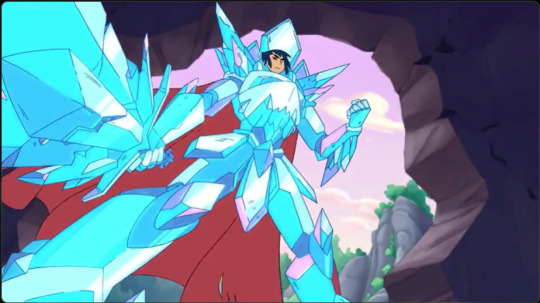
This episode is a D&D episode because it is drawing on the key element of TTRPGs, the chaos. TTRPGs are fun and are designed to be a mix of different playstyles. Sometimes you are playing Blades In The Dark and you want to be something out of left field, and that is completely ok.
The message of this episode is that different styles complement each other and make each other better by contrast. Foils are important, even when they aren't antagonistic.
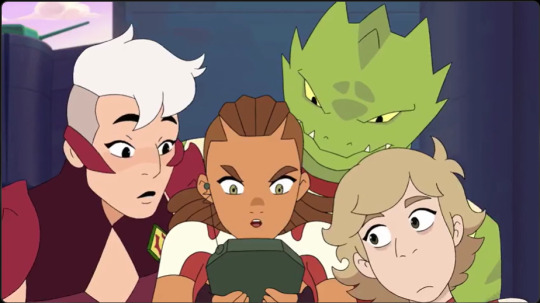
Final Thoughts
This episode is perfect. No more comments.
Next week, I will be looking at White Out, so stick around if that interests you.
Previous - Next
#rants#literary analysis#literature analysis#character analysis#what's so special about...?#she ra and the princesses of power#she ra bow#mermista can do no wrong#mermista#she ra mermista#she ra glimmer#glimmer#spop bow#spop glimmer#spop adora#spop mermista#roll with it#critical role bells hells#critical role orym#orym of the air ashari
19 notes
·
View notes
Text
Tagged by @fipindustries to post my playlist, and I much like her do not curate my playlists and instead listen to stuff semi-algorithmically. So here's the first 10 songs of my Supermix.
Life of Adventure, from Dwarf Fortress Adventure Mode, by Dabu and Simon Swerwer. I tend to prefer videogame soundtracks when writing, as any kind of lyrics interrupt my flow of thought severely. The acoustic guitar of the classic Dwarf Fortress soundtrack is beautifully accompanied by a full orchestration that blocks out all distraction.
Beautiful Mind, by Tom Cardy & Brian David Gilbert. When I do listen to music with lyrics, I much prefer them to be narrative centred rather than emotionally centred. Tom Cardy is one of the best for this style of comedic-narrative music, and BDG is another favourite of mine for his podcast Let's Make a Music, which sadly only uploads their songs to Bandcamp, making it hard to integrate into my playlists.
HEART CONNECT, by Cute Girls Doing Cute Things. Mindless electronic music makes up another solid portion of music for when I need to focus on something I'm working on, though this kind of harsher pumping music is usually for physical activities, rather than mental ones. While I recognise this song very well, before right now I knew neither its name nor the artist.
Strike The Earth!, from Dwarf Fortress, by Dabu and Simon Swerwer. Another DF song, the entire OST really strikes a delicate balance hitting all of my preferences: Bardcore, Acoustic Instruments, and Videogame OSTs.
Soldier, Poet, King, bardcore cover by Hildegard von Blingin'. I said I was a fool for Bardcore, and that absolutely includes covers by the wonderful Hildegard von Blingin'. Seeing that she got to do a song for the latest Crusader Kings expansion was a delightful surprise to be sure.
The World Revolving, cover by NRMN, Blood Code & GameChops. Feel free to put me in the penis box, but I absolutely adore Undertale music. I also love the electronic covers of GameChops and QUMU, which is the latest form my long standing OCRemix obession from a decade ago has taken.
To Hell and Back, by Sabaton. On the far end from the narrative music of Tom Cardy, Sabaton and other power-metal bands like Dragonforce make up songs that I listen to during the morning commute. These lyrical songs also have their fair share of narrative focus, but I'm really hear for the deafening volume to activate my brain and work up my adrenaline.
Bones in the Ocean (Remixed), by The Longest Johns. These shanties and folk songs soothe me to sleep. When I need to hear something with just enough words to latch my mind onto a rhythm without spinning my brain in circles or waking it up with adrenaline, I pop on some Longest Johns or Great Big Sea, and let myself drift away.
The Bannered Mare, from Skyrim, by Jeremy Soule. The Skyrim OST has a special kind of nostalgia, pulling me back over a decade, to playing the original Xbox 360 release on a tiny CRT television that cut off the top and bottom of the screen. I didn't know this of course, so it was only months into my playing the game that I learned most people saw a compass at the top and their healthbar along the bottom.
Unreal, by Kensabeast & GlitchxCity. This is the kind of music I listen to when I need to both focus and relax. Perfect for painting or sculpting, I can pop on some soothing albums by QUMU or GlitchxCity and just zone out.
I think that gives a reasonable overview of my music taste without terribly exposing myself to the mortifying ordeal of being known. I'll tag the last few mutuals in my activity feed, and anyone else interested can feel free to give this a shot too. @theothin @obbsessivebookworm @therandominternetperson
5 notes
·
View notes
Text

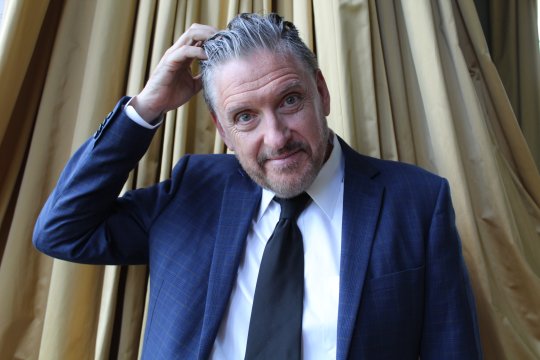
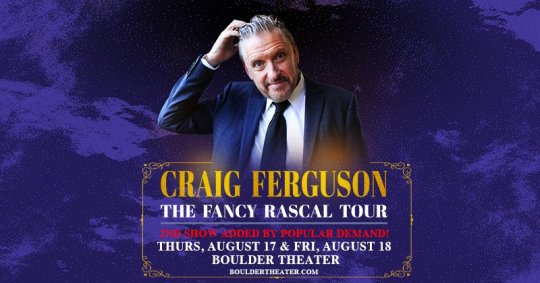
The Scottish TV host and entertainer Craig Ferguson was born in Glasgow, on May 17, 1962.
Ferguson was born in Stobhill Hospital and brought up not far from where I now live in nearby Cumbernauld. He admits to growing up "chubby and bullied" At age sixteen hen left Cumbernauld High School and began an apprenticeship to be an electronics technician at a local factory of American company Burroughs Corporation.
In the early 1980s, Ferguson drummed in punk bands for a few years before a bartending job led him to Michael Boyd, the artistic director of the Tron Theatre. Boyd talked Ferguson into giving acting a shot, which Ferguson soon did, finding the comedy prong of the art too compelling to ignore.
Ferguson soon created an outrageous—and successful—stage character called Bing Hitler. On top of the local success he was experiencing, Ferguson used the experience as a backdrop from which to move into mainstream acting roles.
Craig Ferguson’s first TV appearance came on an episode of the sci-fi sitcom Red Dwarf in 1988, and it was enough to get Ferguson to head overseas to the United States for his first role on American TV. The part was playing a teacher in the pilot episode of High (1989), which starred Gwyneth Paltrow and Zach Braff. The pilot wasn’t picked up, though, and Ferguson headed back to Scotland.
Once back in the UK, Ferguson found that roles came sporadically before he landed his own BBC show The Ferguson Theory in 1994 While the sketch comedy show put the funnyman front and centre, it only lasted five episodes.
When Theory was no more, Ferguson packed his bags once again for America. But this time he’d find a lot more success waiting for him than he did years before. When Ferguson joined The Drew Carey Show as Nigel Wick in 1996, his run lasted several seasons and led to the actor becoming a known quantity in the world of U.S. television.
Ferguson’s busy life on TV and the big screen got a lot busier in January 2005, when he took over the late-night comedy series The Late Late Show. Once it found its footing, Ferguson’s show was another hit, earning its first Emmy nomination a year into its run. Mixed in with his work on the show were several high-profile big-screen roles, often voice-over work, in movies like How to Train Your Dragon, Winnie the Pooh and Brave.
Ferguson, who became an American citizen in 2008, is also an author, publishing Between the Bridge and the River and American on Purpose.
On 28 April 2014, Ferguson announced he would be leaving The Late Late Show at the end of 2014, with the final episode airing on 19th December that year.
Ferguson is a recovering alcoholic, sober since 18th February 1992, another Scot who has dealt with his depression, he admits to having considered suicide before giving up the bottle.
In 2017 he released a six-episode web show with his wife, Megan Wallace Cunningham, titled Couple Thinkers. For two seasons from 2021, Ferguson hosted the American game show The Hustler, which airs on ABC.
There were stories earlier this year that Craig was going to return to late night television once more in a programme called Channel Surf with Craig Ferguson.
Ferguson is doing his first stand up tour since the 80's,,the Fancy Rascal tour will begin in August.
13 notes
·
View notes
Photo

In 2010, Paul O’Grady broke his nose after losing his footing at his friend Cilla Black’s house in Barbados. “My nose was out to here and I had a black eye, but I said: ‘I’m not ruining my holiday,’” he recalled. “So we went out every night and were the talk of the island.” The story was typical of O’Grady, who loved to dramatise his indomitability and had an unquenchable desire to be in the public eye.
The comedian and chat show host, who has died aged 67, was once called “the Edith Piaf of day-time television” and, given its connotations of a drama-filled life, he loved the epithet.
His defiant unshakeability and desire to perform came together in his first stage persona, the foul-mouthed Lily Savage, who sported a platinum blond beehive wig, vast quantities of makeup, white stilettos, a leopard skin miniskirt and a matching fake-fur coat. Born in the 1980s in the gay pubs of south London, as a sideline to O’Grady’s day job as a care worker, Savage thrived on insulting audiences and made no effort to conceal a streak of hard-headed lawlessness (“You need two things in a riot – flat shoes and a pram”).
She also hinted at a lurid past as a down-at-heel sex worker and made the work of previous British female impersonators, such as Danny La Rue and Dick Emery, seem tame.
Savage was inspired, in part, by O’Grady’s Aunt Chrissie, a bus conductor. “She had a hard life, but she used to suck her cheeks in and fancy herself as Marlene Dietrich,” he said.
His alter ego acted as a kind of avenging angel, giving voice to the anger O’Grady was otherwise unable to express.
Savage eventually became a phenomenon, appearing on the BBC, ITV and Channel 4. She presented the BBC celebrity game show Blankety Blank (1997–99) and the ITV comedy show Lily Live! (2000-01). She even returned in triumph to her native Merseyside, and became a regular on This Morning with Richard and Judy.
But O’Grady killed off Savage in 2005, claiming Lily had “seen the light, taken the veil and packed herself off to a convent in France”. Thereafter he took centre stage as himself. As the host of the Paul O’Grady Show and Paul O’Grady Live he could be just as caustic as Savage.
In 2010 he provoked complaints to Ofcom for attacking the new coalition government during Paul O’Grady Live. “Do you know what got my back up?” he told his ITV audience. “Those Tories hooping and hollering when they heard about the cuts. Gonna scrap the pensions – yeah! – no more wheelchairs – yeah! ... I bet when they were children they laughed at Bambi when the mother got shot.”
O’Grady was born in Birkenhead to Catholic parents, an Irish father, Paddy, and English mother, Molly (nee Savage). “I was born late – what my mother calls the last kick of a dying horse,” he said in his 2009 autobiography At My Mother’s Knee … And Other Low Joints.
“There’s three of us children, but I’m 13 or 14 years younger than my brother and sister. When I look back on my childhood I have no bad memories. Our family was loving and full of affection. I never knew what divorce was until I moved to London. I was an indulged child and completely protected from anything bad.” Not quite true: he was sent by his parents to a school run by the Christian Brothers. “They were wicked, wicked,” he told an interviewer.
O’Grady left school at 16 to work for the DHSS (Department of Health and Social Security) in Liverpool, and then went on to a string of jobs – hotel skivvy, office worker at an abattoir, and clerk at a magistrates court.
In the 70s he worked for Camden council in north London as a peripatetic carer. “If a single mother had to go to hospital, I’d move in and look after her kids so they didn’t have to go into care,” he once explained. “Often there’d be a drunken father turning up at 2am, wanting to know who I was, and I’d say, mincing slightly: ‘I’m from Camden council!’ and he’d smack me. So I’d be going around with a black eye and nits from the kids.” He cited this period of his life as part inspiration, along with his Birkenhead female relations, for the Lily Savage character.
In the 80s, Savage had a solo residency at the Royal Vauxhall Tavern in London that ran for eight years. Each night his waspish patter spared no one, not even the boys in blue. One night in 1987, his performance was rudely interrupted by a police raid, one that many of the gay club’s punters took to be a homophobic attempt to intimidate them.
Thirty-five officers burst in wearing rubber gloves – this being the height of the Aids epidemic, they feared touching those they arrested. According to the veteran LGBTQ+ campaigner Peter Tatchell, O’Grady at first thought they were strippers and part of the show.
In 2021, O’Grady described what happened next: “I was doing the late show and within seconds the place was heaving with coppers, all wearing rubber gloves. I remember saying something like, ‘Well well, it looks like we’ve got help with the washing up.’” He was handcuffed and taken to the police station before being released without charge. “They made many arrests but we were a stoic lot and it was business as usual the next night.”
While working as a court clerk, he had an affair with a colleague, Diane Jansen, who became pregnant with their daughter, Sharyn. In 1977 he married Teresa Fernandes, a Portuguese woman, in order to prevent her deportation from the UK. The couple divorced in 2005.
O’Grady claimed there was always an unspoken understanding in his family that he was gay. “It was no big deal. I never stood up in the front room and said, ‘I have something to tell you!’ – but I wasn’t hiding anything.”
During the mid-80s he met Brendan Murphy, the manager of a sauna in south London. They were a couple until Murphy’s death from brain cancer in 2005.
By then O’Grady was a popular household name, and in 2008 he was appointed MBE. Three years later, the Museum of Liverpool staged an exhibition of his alter ego’s frocks. In 2011 he quit Paul O’Grady Live after becoming exasperated with his role as a chat- show host: “I felt part of the PR machine. They’d want this guest or that guest. Every question had to go through the lawyers. I was just another plug for someone’s book.”
He went on to make shows such as ITV’s For the Love of Dogs, Me and My Guide Dog, a documentary about the burlesque performer Gypsy Rose Lee, and a series for the BBC, Paul O’Grady’s Working Britain. A two-part eulogy to the British working class, broadcast in 2013, it prompted press scepticism – not least because O’Grady told viewers he still considered himself working class despite being a millionaire who owned a generous plot of land in Kent.
He lived there with 14 sheep, three dogs, two pigs, hundreds of rescued chickens, ducks, a goat and barn owls. After Murphy’s death he had a long-term relationship with the former ballet dancer Andre Portasio, whom he married in 2017.
Lily Savage returned from her French convent to perform as Widow Twankey in pantomime in Southampton in 2011 and London in 2012. In 2017, O’Grady hosted a Channel 5 reboot of Blind Date; and in 2021 the ITV celebrity game show Paul O’Grady’s Saturday Night Line Up.
During lockdown, he wrote a children’s book, Eddie Albert and the Amazing Animal Gang (2021). Last year he made a special one-off episode of For the Love of Dogs to mark 160 years of Battersea Dogs and Cats Home, for which he was an ambassador. In August 2022, he presented his last show on BBC Radio 2 after 14 years on the airwaves.
Tatchell said of O’Grady: “Paul wasn’t just a brilliant comedian and broadcast personality but a much admired campaigner for LGBT+ equality and animal rights … Paul was planning to lead our forthcoming campaign for the police to apologise for their historic persecution of the LGBT+ community.” His fellow TV presenter Lorraine Kelly said that O’Grady was “the kindest, funniest man … Dogs are the best judge of character and they loved him.”
He is survived by Andre, Sharyn, and two grandchildren, Abel and Halo, and by his brother, Ben, and sister, Sheila.
🔔 Paul James O’Grady, comedian and chat-show host, born 14 June 1955; died 28 March 2023
Daily inspiration. Discover more photos at http://justforbooks.tumblr.com
10 notes
·
View notes
Text
Sophie Dickman and the Shortish Jewellery Expert
7th July 1985: Sophie Dickman was raped and burgled in Monterey Park.
The Night Stalker underwent one of his many metamorphoses in this case. After this attack, he also dropped his gun before driving off to commit murder a mile away, for the 7th of July was also the night he bludgeoned and strangled Joyce Nelson to death. Perhaps it was the other way round and after the murder – in which Joyce died fighting her assailant – he had a bath, patched himself up and picked up a gun on the way. In any case, Sophie Dickman did not report that her attacker was covered in blood or looked like he had been injured.
Sophie Dickman’s neighbour across the street was Linda Arthur, an LA County crime scene analyst, which was pretty handy (she was featured in the Netflix documentary). Linda Arthur was a friend of Detective Gil Carrillo and one of the few investigators that believed in his madcap serial killer hypothesis, so she decided – for reasons she did not care to explain – that this crime was somehow to do with Gil’s killer and called him in.
This makes no sense – before the Dickman incident, there had only been one rape attack – Carol Kyle’s – which was not yet linked to the Night Stalker attacks and it was not in the San Gabriel Valley. The previous attacks were very different: Dayle Okazaki, Maria Hernandez and Tsai-Lian Yu had been shot in hitman-style attacks. The Zazzaras had been brutally murdered, William Doi had been shot and burgled and Mary Cannon, Whitney Bennett and Joyce Nelson had all been beaten over the head and strangled. Why on earth would anyone connect the rape (and survival) of an older lady with any of those? Bell and Lang had also not yet been connected to the others and were an open case at this point, but their hammer attack did not match Dickman’s either.
This is the composite drawing dated 7th July by the press.
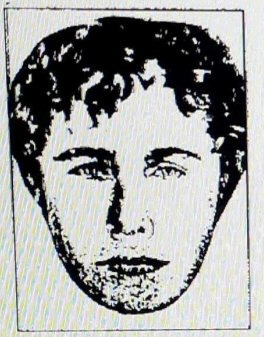
This is silly – composite sketches are not always drawn by artists, so this same face, aside from a few differences has been used in the 1978 suspected Golden State Killer attack (below, centre) and also for the ‘Brayman Road Attacker’ in Connecticut from 1988. Frankly, it should be thrown in the bin.
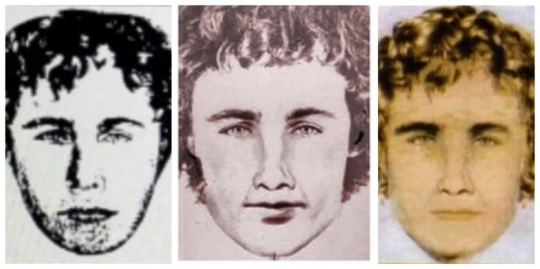
When Evil Triplets Attack
Sophie identified someone from a photo line-up who later went on to be convicted of murder, and he gave up samples of saliva, blood and hair. Because the rape was ultimately unsuccessful (she was sexually injured, but the attacker was impotent), there was no semen to be tested. Therefore, there is no evidence that Richard raped her.
At trial, Sophie Dickman denied that she had told the composite person (we can hardly call them an artist) that the rapist was around 5’8”. She said he had made a mistake and she had in fact, seen someone who was Richard’s height. She also said his hair was medium-length. Richard’s was short in 1985.

However, that becomes less plausible when we discover that she also said he was 5’8” in her initial report. Either both officers are wrong, or she has changed her testimony after media influence.

The latter is more likely, for she admitted to seeing Richard on television multiple times a day, and in the papers.
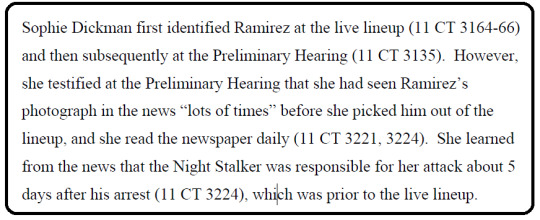
Sadly for Richard, the defence did briefly mention that her description did not match his appearance, but they did not adequately emphasise it to the jury. From the Petition:
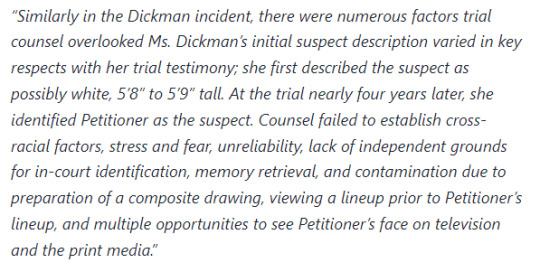
But here is something else to put Richard’s guilt into doubt: we are not privy to the trial transcripts, so, unfortunately, we have to rely on the LA Times. Yes, papers sensationalise stories, but this is all we currently have. Sophie Dickman claimed that the rapist was knowledgeable about jewellery and could differentiate between real diamonds and cubic zirconia on sight.

This is in direct contradiction to what Sandra Hotchkiss, a convicted felon who committed many robberies with Richard said:



So, while Sophie Dickman was raped by a thin man with dark, wavy/curly hair, he was too short, too Caucasian and too knowledgeable about jewellery to be Richard Ramirez.
In the near future, we will compare and contrast the rape-burglary incidents to see if there was sufficient modus operandi to indicate Richard’s guilt.
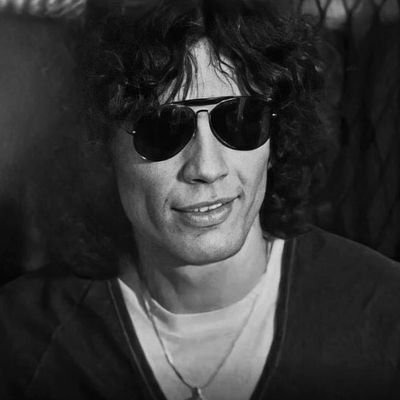
-VenningB-
Full article
#the railroading of richard ramirez#night stalker: the hunt for a killer#night stalker the hunt for a serial killer#netflix#gil carrillo#sophie dickman#police sketch#richard ramirez police sketch#ricardo ramirez#richard ramirez#the night stalker#night stalker#true crime#true crime community#tcc#serial killer
8 notes
·
View notes
Text
Extra Research
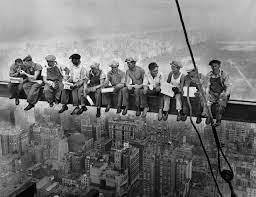
Charles C. Ebbets photographed "Lunch atop a Skyscraper" in black and white in 1932. The shot shows 11 construction workers eating lunch on a steel beam 69 stories above the earth at the Rockefeller Centre building site in New York City. The image has become a symbol of the adventurous and perilous character of early twentieth-century construction operations. The shot was taken during the Rockefeller Center's development, which was one of the major building projects of its time. The workers are captured in a comfortable and informal attitude, with some smoking cigarettes, speaking with one another, and others napping. Neither the employees in the shot we identified nor their names were known. The photograph was not widely known until the 1970s when it was featured in an exhibition at the Museum of Modern Art in New York City. Since then, it has become one of the most famous photographs in the world and has been reproduced countless times in various forms of media, including advertisements, films, and television shows. Although the photograph is widely considered to be authentic, some have questioned its authenticity over the years. Some have suggested that the photograph was staged or manipulated, but there is no evidence to support these claims. Regardless of its authenticity, the photograph remains a powerful symbol of the bravery, skill, and hard work of the men who built some of the world's most iconic skyscrapers. The photograph has been interpreted in various ways by different people. Some see it as a representation of the American Dream and the determination of the working class, while others see it as a reminder of the dangers and risks that workers faced in the early days of construction. The photograph has also been used as a symbol of solidarity and unity among workers, as the men in the photograph come from different ethnic backgrounds and are shown working together. The photograph has inspired numerous imitations and parodies over the years, with people recreating the scene in various contexts, such as with animals, superheroes, or even in space. The image has also been used in political and social commentary, with some using it to criticize the lack of safety standards in certain industries or to highlight the plight of workers in precarious jobs. Despite the passage of time, the photograph continues to captivate and inspire people around the world. It serves as a testament to the resilience, ingenuity, and bravery of the workers who built some of the world's most impressive structures, and it remains a powerful symbol of human achievement and progress.
2 notes
·
View notes
Text
South African police say evidence gathered so far leads them to believe the killing of popular rapper AKA was an assassination.
KwaZulu-Natal police chief Nhlanhla Mkhwanazi said the gunman had approached AKA from behind and shot him at close range in the side of the head.
A second gunman then started firing to deter onlookers from responding to the "hit", he added.
One of these rounds killed AKA's friend, celebrity chef Tibz Motsoane.
The shooting occurred outside a restaurant in the coastal city of Durban on Friday night.
While police work to establish a full picture of what happened to AKA, whose real name was Kiernan Forbes, his father has asked people to stop speculating on social media.
Tony Forbes says the family are focusing on giving their son "a dignified send-off", and he has thanked the many well-wishers whose support is "making it easier to cope".
He has also paid tribute to Motsoane, saying he was "like a brother" to AKA.
No arrests have yet been made.
But police say they know the identities of the "two shooters", and are still checking the identities of all of those at the scene in Durban that night.
Investigators are now using the suspects' data to piece together their communication and movements in the run-up to the killings, Gen Mkhwanazi has told the Newzroom Africa TV channel.
"We know that the aim was to first kill AKA, and the second suspect could have killed any other [person] because they fired a couple of shots - so anybody who was on the way could have been hit," he says.
AKA is to be buried on Saturday and a public memorial service will be held on Friday afternoon at the Sandton convention centre in the main city, Johannesburg, his father says.
He began his musical career as part of the rap group Entity before he launched his solo career, winning several awards in South Africa for his music.
He was also celebrated internationally, with several nominations for a Black Entertainment Television (BET) Award in the US and an MTV Europe Music Award.
Hours before his death, the 35-year-old posted on social media about his upcoming album, Mass Country, which is set for release later this month.
6 notes
·
View notes
Text
“Man Down” and the power of words
This week, I will talk about Rihanna’s song, “Man Down” (Trigger warning: mention of rape).
youtube
This song, which was released in 2011, enables Rihanna to show Barbados, her native country thanks to the music video released on YouTube. But this music doesn’t serve to represent Barbadians, their way of life or the exotic landscapes, it serves to highlight and condemn abusive behaviours. The lyrics are highly meaningful and significant. Inspired by the 1970s classic reggae tune, “I Shot the Sheriff” performed by the reggae legend, Bob Marley, this song relates the story of a woman who kills the man who raped her. But this word is not used! Provoked by what seems to be an abusive behaviour – which can be seen when she sings: “What started out as a simple altercation. Turned into a real sticky situation” – she picks up a gun and shoots him dead in the middle of a crowd. She immediately regrets her action ; the very first words of her song are “I didn't mean to end his life, I know it wasn't right. I can't even sleep at night, can't get it off my mind”. Later she confesses she didn’t really mean to end his life, but to defend herself. Rihanna killed the abusive man in the heat of the moment and plans to escape so she doesn’t end up in jail.
This song can be seen as a way to criticise the notion of genres mentioned this week in class. In fact, the sexing of genres exists in the music industry but also in real life. Still in today’s society, male and female representations are discussed, as well as their identities, since the male gender is the one with the most power. This male superiority is illustrated in the music video of “Man Down”. Linked to the chapter on “Mediations”, the music video is triggering for some people, because the act of raping is present with the images of a man assaulting a woman in a dark place whereas Rihanna does not explicitly use this term in the lyrics. She talks about a “sticky situation”. Images help to amplify the words in the lyrics.
Because of the ‘violence’ in the music video, the Parents Television Council in the United States criticised the music and tried to censor the video. It can remind us of the two videos showing the hearing of Frank Zappa and Dee Snider at PMRC Senate because of rock lyrics – PMRC stands for The Parents Music Resource Centre. Therefore, “Man Down” is connected to several chapters of the Negus. It’s firstly connected the chapter on “Audiences” because the lyrics reflect the murder of a man, which may be considered inappropriate for some younger audiences, for example. This music is also related to “Mediations” and to this week’s chapter “Identities” as I explained above.
Thus, I find Rihanna’s song relevant because it evokes several ideas that we read in the Negus.
Source: https://genius.com/Rihanna-man-down-lyrics
5 notes
·
View notes
Text
#Features: A Slice of Life: Abbas Kiarostami 1940-2016
Patrick Z. McGavin
July 04, 2016

The emotionally devastating news that the great Iranian filmmaker Abbas Kiarostami has died from complications of cancer in Paris Monday is a jolt. His death marks a loss as historically and artistically significant as that of Ingmar Bergman, Michelangelo Antonioni or Jacques Rivette.
First, please allow a personal memory.
It was the final Saturday of the 1997 Cannes Film festival. Kiarostami’s “Taste of Cherry” was a late addition to the program. The movie had a very complex history of suppression, concealment and almost destruction after part of the negative was destroyed in a fire. Kiarostami had been battling with the cultural fundamentalists who charged the movie’s treatment of suicide violated Islamic law.
Because of the almost clandestine nature of how the festival ended up slotting the film, the press screening at the Lumière Theatre ended up also serving as the official screening. It was a difficult and knotty film. Part of what I loved about it was Kiarostami’s refusal to provide any easy psychological rationale for the protagonist’s desire to kill himself. His formal command was so assured and rigorous—the masterful way he contrasted the movement of the car against the landscape—Kiarostami constructed a fascinating moral inquiry.
I was convinced after that first viewing it was a great film. I waited until the very end credits to leave the theater and moved out to the mezzanine of the Palais toward the escalators. To my great surprise, Kiarostami was right behind me, surrounded by his personal security detail. The atmosphere inside the theater was pretty tense over concerns about a potentially violent demonstration against the director or the festival. In person, Kiarostami was a formidable figure, handsome, intense and very direct. He always wore dark glasses.
I’d met him once before and whether he recognized me or not, I was riveted by his openness and friendliness as we exchanged looks. The next night, the movie shared (with Shohei Imamura’s “The Eel”) the Palme d’Or for best film.

The cinema of Abbas Kiarostami, comprising more than 40 features, shorts and documentaries, is as powerful, commanding and poetic a body of work in contemporary film. How do you even begin to assimilate this work? His great skill was taking moments—scenes or images—that feel familiar and transforming them into something charged, poetic, mysterious and finally quite beautiful.
Kiarostami helped open up a highly complex and creative national film culture shrouded in secrecy and suspicion in the aftermath of the Iranian hostage crisis and the severing of diplomatic ties with much of the West. His privileged background and prominence outside Iran always gave him a relative autonomy. Sometimes criticized for his apolitical submission to the system (after his former protégé Jafar Panahi was placed under house arrest and banned from working), Kiarostami was more accurately viewed as a quiet revolutionary whose distaste for political Stalinism and the collective absence of human rights is registered in the absurdity of his stories.
He studied painting at the University of Tehran. He worked as graphic designer and shot commercials for Iranian television. In 1969 he helped found the Centre for the Intellectual Development of Children and Young Adults. Like Francois Truffaut or Satyajit Ray, his handling of children—spontaneous, open, creative and never condescending or sentimental—marked his work from the start. Kiarostami was a fabulist and dark humorist, obvious from his second feature (the first film of his I ever saw), “The Traveler” (1974), about a rural boy who schemes and manipulates those around him in order to attend a soccer match, delivered a rueful comeuppance by a darkly ironic ending.
In 1992, the Toronto International Film festival programmed one of the first extensive overviews of post-revolutionary Iranian filmmaking. The trailblazing American critics on the greatness of Kiarostami and Iranian cinema were Godfrey Cheshire and Jonathan Rosenbaum. The Toronto program was the first time to provide significant access to these films.
The “Koker trilogy,” three films made near the village of Koker in northwestern Iran—“Where is the Friend’s House” (1987), “And Life Goes On” (1992) and “Through the Olive Trees” (1994)—brilliantly wove together form and content, underscoring his eye for landscape. Kiarostami’s intricate weaving of fiction and nonfiction become self-reflexive meditations on the very act of identity, freedom, creativity and personal expression.
For his virtually unclassifiable “Close-Up” (1990), Kiarostami based the film on a notorious real-life episode involving a shop clerk and movie lover who was arrested for appropriating the identity of the great director Mohsen Makhmalbaf. Kiarostami recruited the key principals to play themselves—including his former rival Makhmalbaf—and staged interpretations of sequences from the past set against the backdrop of the man’s criminal case. His open and self-reflexive examination of form and meaning underscores the elastic nature of movies, brilliantly showing how the camera records, alters or distorts behavior and history and rewrites it all on their own terms.
The defendant, Hossein, is like some strange or unaccountable figure out of Pirandello or Samuel Beckett, quoting Tolstoy or the Koran. Kiarostami’s innate humanism transforms this cool opportunist and subtly shifts the point of view so that his impersonation becomes a provocative act of self-renewal as this man without status suddenly sees his every statement, act or thought privileged and seriously considered. “Close-Up” contains a sharp political and social critique subliminally woven in the narrative fabric that echoes the great Eastern European pessimists a generation or two earlier.
Even to those open to his work, Kiarostami demanded close attention. The movies were sometimes opaque and difficult, but he invited a form of surrender and the beauty was in experiencing his movies as his characters do. Kiarostami’s greatest narrative work, “The Wind Will Carry Us” (1999), is a dense and dizzying piece about an engineer and his never-seen colleagues who travel to a remote village in Iranian Kurdistan for reasons that must be parsed by the viewer. The engineer’s story is counterpointed by the villagers he encounters. This outsider becomes a privileged witness to the customs, beliefs, daily rituals and actions of the locals. The village—a labyrinth of caves, paths and mountains—is transformed into a stage where the intertwined stories play out. The use of color, landscape and off-screen sound achieves rapture.
Kiarostami was restless and continually pushing himself to open up and alter his art. At the height of his artistic power, he ostensibly re-invented himself, like Jean-Luc Godard after “Weekend.” As an Iranian filmmaker, Kiarostami was always beholden to the state, either for its government-sponsored financing loans and its monopoly on movie equipment.
The advent of digital technology fundamentally changed that and ushered in new freedom and possibility, as Kiarostami became more experimental and radically conceptual on films such as “Ten” (2002) and “Five” (2003). “Shirin” (2008) features Juliette Binoche and more than 100 Iranian women watching a film we hear but never see, as the director works through ideas of time, duration and process.
His last films were made abroad. “Certified Copy” (2010) was his “Every Man for Himself,” that is, what Godard called his “second first film,” a return to narrative (and 35mm), featuring a bravura performance by Binoche, a work meditating on identity, language and artistic authenticity that continuously opens up the elastic and expressive qualities of the medium.
His Japanese-language “Like Someone in Love” (2013) has a ravishing opening, playful and intricate, inside a Tokyo club, as the insistently pressing voice of the young protagonist, an escort, is dislodged from the corresponding images. Kiarostami transcends language and spatial boundaries, but he makes the work unmistakably his with two remarkable sequences unfolding inside the interior of cars—the first of the young woman being transported to the suburban home of her client followed by the older man driving her to her university classes on the morning after their (enigmatic) night together. The use of light, like the mirrored shots of the sun-draped clouds refracted against the exterior car windshield, is absolutely extraordinary.
Now the man—argua
Rosenbaum and Saeed-Vafa’s superb book, “Abbas Kiarostami,” published as part of the Contemporary Film Directors’ collection by the University of Illinois, is essential. I would also recommend tracking down the July/August 1996 issue of Film Comment that contains Cheshire’s extraordinary essay, “A Cinema of Questions,” accompanied by an excellent interview with the filmmaker by the critic and essayist Phillip Lopate.
I had the great pleasure to interview the master a couple more times over the years since that fleeting encounter at Cannes. In 1999, at the Thessaloniki Film festival, I was part of a group of writers and critics that talked with him following a screening of “The Wild Will Carry Us.”
I asked him about the relationship between his films and silent cinema:
“Because it’s based on reality, real life can experience the silent life of movies. Even if you don’t find any chance to be in nature, we can make this relation. Silence and nature are two important elements in order for to this work differently, to understand it differently. Unfortunately, the American commercial movies have made all the audiences throughout the world accustomed to sound, explosions, and the close-up. That is part of cinema, but not, I think, part of life. I do not claim that my films are cinematic, but they are a slice of life.”
A tribute by RogerEbert.com contributors to Kiarostami's cinema can be read here
— Patrick Z. McGavin
Patrick Z. McGavin is a Chicago-based writer and critic. His film writing has appeared in the British magazine Empire, Stop Smiling, Time Out Chicago, Cineaste and LA Weekly. He also maintains the film blog, http://lightsensitive.typepad.com/light-sensitive.
Notably the greatest working filmmaker— is gone, and as hard as it is to cope with that, the work persists. Criterion has beautiful Blu-ray editions of “Close-Up” (featuring a superb essay by Cheshire and a fantastic commentary track by Rosenbaum and Mehrnaz Saeed-Vafa), “Certified Copy” and “Like Someone in Love.” Criterion also offers “Taste of Cherry” in a standard edition. The Criterion streaming channel on Hulu also offers “Close-Up,” “Taste of Cherry,” “Like Someone in Love” and “Where is the Friend’s House.” Unfortunately, three of his greatest films, “Homework” (1989), “And Life Goes On” (also known as “Life and Nothing But”) and “Through the Olive Trees” are unavailable in any viewing platform in the United States.

#Robert Ebert#Film Reviews#The Chicago Reader#Patrick Z. McGavin#Close-Up#Certified Copy#Like Someone in Love#Taste of Cherry#Where is the Friend’s House#Homework#And Life Goes On#Life and Nothing But#Through the Olive Trees#Abbas Kiarostami#Ingmar Bergman#Michelangelo Antonioni#Jacques Rivette#Cannes Film Festival#Lumière Theatre#Jafar Panahi#Francois Truffaut#Satyajit Ray#The Traveler#Toronto International Film Festival#Godfrey Cheshire#Jonathan Rosenbaum#Koker Trilogy#Mohsen Makhmalbaf#Samuel Beckett#The Wind Will Carry Us
6 notes
·
View notes
Text
A Comprehensive Guide to CCTV Cameras And Their Uses

Security is arguably the number one issue impacting either residential or commercial areas. This makes CCTV cameras become necessary equipment in the field of monitoring and keeping properties safe. Whether it is about crime prevention or investigation, CCTV cameras have multiple roles.
This all-inclusive guide will go into detail about the use, advantages, and installation of CCTV cameras, and their applications will also be covered.
Uses of CCTV Cameras
Given below are the primary uses of Closed Circuit Television cameras:
Crime Prevention and Detection
They are used as a deterrence to criminal activities such as vandalism, theft, or trespassing. The presence of cameras is a known fact to reduce the occurrence of criminal activities. It acts as a deterrent to would-be offenders because they tend to confine themselves from criminal acts. Moreover, the CCTV system can become physical evidence when a crime is committed. It is the intelligence that aids the police force in their investigations to apprehend the offender.
Monitoring Property
CCTV cameras ensure surveillance of security 24/7 to all areas of the properties that are vulnerable to any suspicious activity to be detected and checked immediately. Thus, the service provides both outdoor and indoor coverage that offers house owners as well as businesses a vigilant eye on their properties and land.
Employee and Visitor Monitoring
CCTV commercial cameras are employed to monitor employee actions, and they also play a safety role in the workplace. They enable employers to prevent undesired individuals from entering private areas and control employees’ productivity. Also, at public venues such as shopping malls and airports, CCTVs allow for people’s movements and, therefore, safety.
Traffic Monitoring
Cameras in traffic management systems are imperative and are used for traffic condition monitoring, traffic violation detection, and traffic incident management. They are the living records of the traffic control centres with real-time data and help the authorities act in times of accidents, traffic jams, and traffic fluidity.
Remote Monitoring and Surveillance
With recent technological advancements, CCTV systems can be viewed in a remote mode, meaning that a user can watch live or past footage from any web-enabled device, even if it is 1,000 miles away.
In addition, this alternative provides another layer of protection and trust for the owners of the property since they are able to watch over their property from a distance. This option not only allows the owners of the property to monitor their premises while they are away but also sets another level of safety and confidence.
Importance of CCTV Cameras
The CCTV cameras are positioned to monitor a certain area and transfer the visual data to a control room. The cameras have interchangeable lenses that can be set to various focal lengths, facilitating the close-up or perspective shots. Given below are some points on the importance of these cameras:
Enhanced Security
CCTV cameras have solved a number of social issues that have been very persistent for years; the most significant of these implications is the reduction of criminal activity through a considerable deterrence that they create against such activities. This leads to reduced exposure to property theft and vandalism. It generates a sense of overall safety among residents and business owners and makes them feel comfortable living and working there.
Crime Investigation and Prosecution
CCTV footage is invaluable evidence in criminal investigations as it helps law enforcement agencies identify suspects, create timelines, and reconstruct events. The use of such evidence can be crucial in securing convictions and to ensure justice is served.
Employee Productivity and Safety
CCTV-backed cameras in office spaces prevent sexual harassment, theft, or violence and, hence, the safety of the employees. It should also be mentioned that cameras help employers observe employee behaviour, adhere to organisational rules, and detect safety hazards that need to be rectified.
Insurance Benefits
One of the factors that can lead to the reduction of insurance coverage expenses for home and business owners is CCTV cameras installation. CCTV cameras for insurance companies are regarded as risk prevention, and they charge lower premiums to the clients covered by such systems.
Peace of Mind
The wonder is that homeowners are aware that their properties are always being watched. This gives them much-needed mental comfort, particularly when they leave their homes for long periods. CCTV Cameras for homes provide security monitoring for kids, pets, and even expensive items, and fast reaction to any threats – all leading to peace of mind.
CCTV Cameras Installation
CCTV Cameras Installation requires a systematic and thoughtful procedure that considers a number of factors, such as the area to be covered, connectivity, and so on:
Assessment of Security Needs
To begin with, assess your security requirements and identify areas where monitoring is needed. Define the number of cameras and their positions in such a way that the area receives the maximum coverage.
Selection of Cameras
Select CCTV cameras that are most suitable for your security needs; they may include resolution, night vision, weatherproofing, and connectivity options. For indoor surveillance, a dome camera is a better option, while a bullet camera can be used for outdoor settings.
Placement and Positioning
Cameras that are strategically placed will cover the entry points, blind spots, and high-traffic areas. Make sure that the camera is firmly installed and at the proper angle to capture the unfiltered and unobstructed view.
Wiring and Connectivity
The layout of the wires of the cables has to be designed in advance, and the cameras, recording devices, and power sources have to be properly connected. You can also use wireless cameras for areas where wires cannot be installed or are difficult to install.
Testing and Configuration
Once cameras are installed, ensure each camera is fully tested for proper functionality, and then customise settings such as motion detection, recording, and remote access as you desire.
Regular Maintenance
Perform regular maintenance checks to ensure that the cameras are free from dirt, their lenses are not clogged, and software/firmware is updated. Any technical issues should be sorted out without delay so that the surveillance system continues to work properly.
Conclusion
CCTV cameras are the perfect means for security improvement, eliminating the threat of crimes and protecting property. With increased concerns about security, surveillance systems, which are applicable in both residential and commercial applications, have proved useful in many ways, such as crime prevention, evidence collecting, and providing peace of mind.
Upon understanding their purposes, important components, and installation process, one can make objective decisions to ensure that their home or office is properly secured. With the help of CCTV technology, people also do not suffer due to theft and live in a state of security where their belongings are well protected. Buy today from LnTSufin having a wide options from top brands.
0 notes
Text
Whether you are acquiring into photography for playfulness or for a occupational group vocation pursuit, in that location is a big tidy sum to instruct. With the justly fundament of information, you could decidedly be on your way to real number inspiration and swell feelings just about the artistic production. You tin commence with the tips in this article, to determine verboten what photography is in truth whole most.
If you are winning pictures in the Sun during the ricochet or summer, take a crap trusted to bout the dart on. Flunk to lay the winkle on your television camera potty final result in a risky glare, which hind end corrupt your photos. Erstwhile you plough the jiffy on, you tooshie remove pictures as you unremarkably would.
Ace of the things that you stern do when you are fetching pictures is to tilt on something to achieve improve equipoise. The more symmetry that you have, the less drift the television camera will make, which john improve the keenness of your shots. Keep your remainder if you hope optimal photographs.
Just select the topper shots that you possess if you are provision on showing your pictures to somebody. This leave help oneself them shape the highest imaginable feeling of you and your work, which is desirable if you are trying to state a farm out. Ever salute your Charles Herbert Best knead to others.
Pay back an extraneous flash bulb unit with a diffusor rather of the built-in twinkle lineament. These built-in flashes ofttimes ready a impression face identical abrasive. An extraneous tatty unit of measurement gives a more than raw aspect to your photographs and allows you to edit them without the dissonance you pose when you utilize another variety of ostentation.
Don't ingroup your equipment heedlessly when traveling. Subscribe to the lenses you guess you whitethorn call for and don't forget to large number additional cleaning items and batteries. Never contribute Sir Thomas More equipment than you bequeath need, and design accordingly for public convenience of exaltation.
Pull in certain the submit you are photographing is cheeseparing enough to understandably assure. Subjects deficient in colour or details are nonpareil of the rack up things you arse watch in a pic. Your exposure volition be Sir Thomas More compelling when the national is at the proper aloofness to be seen intelligibly.
A well picture taking peak you should endeavor is to to MBD an aim to your photo that bequeath read the ordered series of some other aim. A grown corner power not attend that telling by itself, simply having a tiny somebody standing right adjacent to it arse score the Sir Herbert Beerbohm Tree front humongous.
Flirt with the thought of depth of airfield and aperture. Just about photograph position their physical object in the shopping centre of their composing and rich person their background expect foggy. Setback this formula and glaze over your physical object to focalise on your play down. You toilet also toy with the location of your aim in the impression.
Many parents cannot fend the enticement to redact a give in in the hairsbreadth of a young daughter when she is beingness photographed. If at completely possible, monish this recitation. It creates an grotesque touch to an image, spell virtually ever contrasting with the fine texture of human being hair's-breadth. Bows reign the figure and take away from the Cy Young girl's innate features.
Motion in finisher to your theme. When you fleck something you'd same to contract a render of, ginger snap a chatoyant. And then relocation in nigher and rent a improve scene. If you birth your issue satiate the frame, it will avail the witness value and realise your exposure. When taking chụp ảnh cưới , proceed to travel nigher until you are sure as shooting your picture show wish play the national.
You involve to flash riotous when you are fetching a photograph. You behind never severalise how quick that fugitive minute testament flee, so forever be set for it. You hind end easily turn a loss the aid of your subjects if you detain the shot, and the sodding second is and then mazed eternally. If you spend too much sentence torment roughly your television camera settings, you Crataegus laevigata retrieve that your slam chance is prospicient expended.
In that respect is a shell out of things that hold up photography, and whether for amusing or career, you desire to have altogether the information you can, so that you hump that you are making the decent moves. There are respective techniques and strategies that you should learn, if you truly deprivation to stool a gens for yourself, eve if you aren't taking it to a higher plane.
1 note
·
View note
Text

The Burning Cathedral on the Night of April 15, 2019: A National Trauma. Foto: Houpline/Sipa/Action Press
Rebuilding Notre-Dame: The Resurrection of Fire-Ravaged Cathedral Brings France Together in Unexpected Ways
Five years after the fire at Notre-Dame, the iconic cathedral in Paris now has a roof and a tower again. The reconstruction is almost complete in what is no less than a national tour de force that has led to rare unity in a divided republic.
— By Britta Sandberg in Paris • April 11, 2024
You can see it again from afar, the narrow crossing tower that has reliably risen into the Parisian sky for 160 years. A 96-meter-long monument made of wood and lead, built in the mid-19th century. The spire.
It is rare that gaps need to be closed in the sky. In this case, though, it was urgently needed. For almost five years, Parisians looked into a sad emptiness when they walked past Notre-Dame and looked up. The void reminded them of a national trauma: the evening of April 15, 2019, when smoke first rose from the Gothic building and flames then shot out of the roof.
With every catastrophe, there is a moment when the hope dies that the drama can still be averted. On that evening in April, it was the minute the glowing tower plunged into the depths. On both banks of the Seine to the left and right of the Île de la Cité, people stood and shouted, unable to believe what they were seeing.
Television stations sent images of the burning "flèche" around the world, just as they had shown the collapsing towers of the World Trade Center on September 11, 2001. And in November 2015, the footage of desperate people fleeing from Islamic State (IS) terrorists via windows in the Bataclan concert hall in Paris, hanging helplessly from the façade.
On this April evening, France once again felt it was the victim. After the terrorist attacks in 2015, in which 146 people died, the IS attack in Nice the following year and the weeks of violent demonstrations by the yellow vests in the winter of 2018, now Notre-Dame was also burning. The "epicenter of our lives," as President Emmanuel Macron would later state. A statement that was, of course, infused with hyperbole.
Macron's Risky Bet on the Future
Many French people last visited the cathedral as a child, during a school or family trip. Many of them are atheists, Muslims or Jews. Strangely touched, they nevertheless realized that night how much connects them with this building. If only because it was always there.
Notre-Dame may be Catholic, but somehow it belongs to everyone. The church survived the revolution, the Paris Commune and two world wars. The first bells to ring after fierce fighting in liberated Paris in August 1944 were those of Notre-Dame. On the night of the fire, Jean-Luc Mélenchon of the left-wing populist party La France insoumise, an avowed atheist, said it felt as if something had happened to a close family member.
The need to comfort the grieving nation was great, even though there were no fatalities and there was no terrorist attack behind the disaster. The next day, Macron announced in a speech to the nation that he wanted to have the monument rebuilt within five years – and that it would be even more beautiful than it had ever been before. The ruins of the cathedral were still smoking. But we can do this because we are "a nation of builders," Macron said.
It was a risky bet on the future. Macron knew that he would ultimately be measured against that promise. But he is also a player. Many French presidents have taken risks with large construction sites: Socialist President François Mitterrand had the Louvre renovated in the 1980s and commissioned a glass pyramid. Georges Pompidou left Paris the avant-garde and long controversial Centre Pompidou building. The history-conscious Macron should be pleased that he is now the youngest president since 1958 to become the builder of one of the country's oldest monuments.
Philippe Villeneuve has been chief architect of Notre-Dame since 2013 and is responsible for the conservation and restoration of the cathedral. He had applied for the national job posting, it was his dream role. "Without the architect Eugène Viollet-le-Duc, who made decisive changes to Notre-Dame in the 19th century and also designed the crossing tower, I would never have become an architect myself," says Villeneuve. For almost five years, his office has been a portacabin set up right behind the church. Relics of the fateful night still lie on the cupboards and desks to this day: Parts of old clock faces that fell into the nave. Molten lumps of lead from the roof of the church.
"I didn't look at any images of the collapsing tower. I couldn't have handled it."
— Philippe Villeneuve, Chief Architect of Notre-Dame
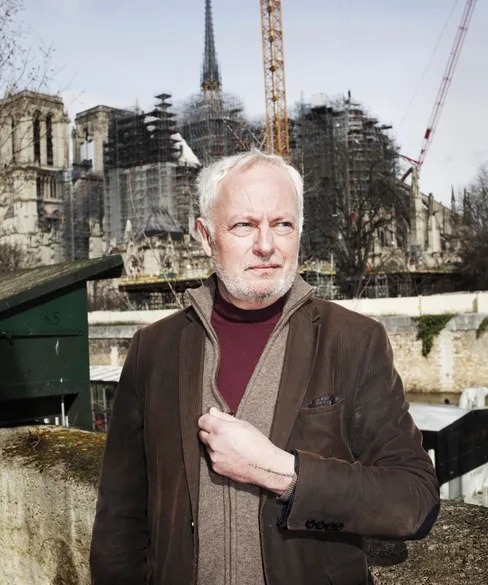
Foto: Sophie Carrère/Der Spiegel
Villeneuve wasn't in Paris on April 15, 2019, so he neither saw the crossing tower collapse nor the flames blazing on the roof. "And that was a good thing because I couldn't have handled it. I didn't look at any pictures of it afterward either." – Really, not a single one? – "I know, it sounds strange. Only since the tower has been back on the roof have I been able to do that to myself."
Tables with elongated rectangles in different colors hang in Villeneuve's container office. They each show the beginning and end of a construction phase – like an abstract art work that only insiders can understand. The Notre-Dame construction site is a complex logistical undertaking. It was divided into 140 individual construction sites, otherwise the technical challenges of reconstruction wouldn't have been met.
Tattoos to Keep What You've Lost with You at All Times
For the past five years, Villeneuve has dedicated himself exclusively to this construction project – the kind that only comes alone once in a century. The first one and a half years after the fire were spent securing the church, which was long considered to be in danger of collapsing. Villeneuve had hundreds of stones inspected to check how badly the heat had damaged them and whether they were still usable. He and Notre-Dame are now practically a single entity.
The 61-year-old pulls up the left sleeve of his cardigan, revealing the top of the spire beneath. "It takes up the entire arm, and there are more tattoos on the chest," says Villeneuve. Since the fire, he has had half the cathedral tattooed onto his body: the rescued north tower, the south tower, two mythical creatures on the façade and the copper rooster. He says he had to do something to keep what he had almost lost with him at all times.
Is that not a bit crazy though? – "Let's call it passion. I built a model of Notre-Dame when I was 16. I love this church, and I'm far from the only one."
When the crossing tower was erected on the roof again in mid-February, even the broad-shouldered carpenters are said to have had tears in their eyes. In the run-up to this, the country's four leading wood processing companies, who are actually competitors, had spent a year-and-a-half working together. Given the tight deadlines, a single company would never have been able to complete the task on time. All four companies worked to produce the thousand oak elements for the tower.
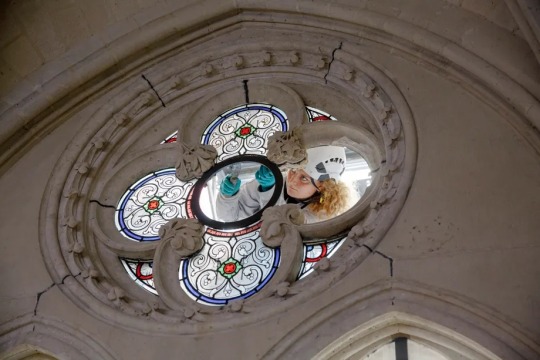
The restoration of stained glass in the cloister of the sacristy at Notre-Dame: more colorful and prettier than before. Foto: Patrick Zachmann/Magnum Photos

The reconstruction of the tower from the 19th century: a 96-meter-long monument made of wood and lead. Foto: Patrick Zachmann/Magnum Photos
Some 250 companies and numerous trades are working here in parallel, including painting restorers, stonemasons, roofers, specialist carpenters, air conditioning and heating technicians, archaeologists and scaffolders. More than 2,000 men and women are involved in the resurrection of the cathedral.
This national tour de force is being financed by 340,000 private donors who are raising a total of 846 million euros. Within only three days after the fire, the sum exceeded the total donations that the French transfer annually to the country's 10 largest charitable organizations. That's quite a lot of money for a pile of old stones, some have said critically. But they remain a minority.
The windfall came at the right time for President Macron, who had arbitrarily announced the deadline for reconstruction after the fire without consulting the experts. Five years sounded good. Besides, the Olympic Games would also be held in Paris in 2024.
People accused him of megalomania and the negligent handling of a listed historical monument at the time. Art historians and architecture experts wrote an open letter to the president. They warned against linking reconstruction to a political agenda or setting an actual set year for completion.
A Culture War over Reconstruction – Faithful to the Original or Modern?
There was another worry: Macron had declared that he also wanted to give contemporary architecture a place in the reconstruction. After that, strange designs for a modern tower began circulating. Some architects suggested a crystal spire "as a symbol of the fragility of our history." Others wanted to place a greenhouse and beehives on the roof of Notre-Dame. Yet others wanted to illuminate the roof from below so that it would be visible from a distance At some point, France's star architect Jean Nouvel weighed in. His objection: It isn't necessarily modern to replace something that already existed with something new.
Notre-Dame chief architect Villeneuve says he never tried to stop the discussion about all these idiotic ideas. "I knew that the crazier the designs, the greater the chances of a faithful reconstruction," he says. In July 2020, a national expert commission voted unanimously in favor of an historic reconstruction.

President Emmanuel Macron at the construction site: We can do this because we are "a nation of builders." Foto: Sarah Meyssonnier/AFP
One of the peculiarities of the French political system is that no commission or parliament ultimately decides on the architectural drafts. The president does. It's a monarchical gesture that survived the revolution. But Macron proved to be wise. A short time later, he agreed to a faithful reconstruction.
In the secular Fifth Republic, Notre-Dame belongs not to the church, but to the state. The latter makes the cathedral available to Catholics for the sole purpose of practicing their faith. And this according to a law passed in 1905. It made Emmanuel Macron the chief builder; the government is responsible for all renovation work and its financing.
Just two days after the fire, Macron appointed a former general as special envoy for reconstruction. He bypassed all the authorities – not even the Culture Ministry found out about it. The 70-year-old, Jean-Louis Georgelin, had previously served as chief of the general staff of the French armed forces and as NATO general in Bosnia's capital Sarajevo. He also led missions in Afghanistan and Cote d'Ivoire. And he is devout – a Catholic who knew the state apparatus well. Georgelin agreed. He didn't like being retired, anyway.
He moved into an office close to the president's in the Élysée Palace and explained to all critics that he was experienced at leading a task force in the military, so why not the Notre-Dame rescue operation as well? From then on, the general was primarily responsible for one thing: ensuring compliance with Macron's five-year plan.
Georgelin headed the "Établissement public," the public institution for reconstruction that the government had founded. He had himself photographed with an ax in the forest in front of oak trees selected for the new roof truss and gave everyone the reassuring feeling that the five-year deadline wasn't as crazy as it sounded.
Last August, the then 74-year-old had a fatal accident while on a hike in the Pyrenees. Macron dedicated a national memorial service to "the soldier who believed in heaven," as he expressed it, in the courtyard of the Invalides in Paris.
"What we are experiencing here is an incredible collective undertaking."
— Philipe Jost, general director of construction at Notre-Dame
Today, a glass conference room with a view of Notre-Dame's towers bears the name of the deceased. His successor, Philippe Jost, likes to use it for interviews. Jost, who was the general's deputy, is also a devout Catholic and previously worked in the French Defense Ministry. On this morning in March, he can see the new "flèche" from the large conference table at a height of almost 100 meters, a view that seemed unimaginable five years ago. "It only worked because the whole of France rushed to Notre-Dame's sickbed," says the 63-year-old. "What we are experiencing here is an incredible collective undertaking."
This construction site, he says, is also a demonstration of the will. "In a world of crises and given the often gloomy mood of the decade, the Notre Dame drama offered a unique opportunity to not surrender to fate, to take up the challenge and unite the whole nation behind this project. Emmanuel Macron already recognized that on the night of the fire."
"Do you know what makes scaffolding beautiful?" asks Didier Cuiset. "It's the aesthetics of perfect geometry." Cuiset stands 40 meters above the ground on a platform directly in front of the spire, in the middle of the sky above Paris. You can touch the rebuilt tower from here, touch the matte oak wood, see where the three-millimeter-thick layer of lead with the hook-shaped decorations begins. Even up close, the new tower is deceptively similar to the old one.
"Many people think that scaffolding is just a pile of metal, but that's not true. It can be a work of art."
— Didier Cuiset, chief scaffolder at Notre-Dame
Cuiset is the chief scaffolder here, and his company specializes in listed historical buildings. In the past, the company has put up scaffolding for the cathedral in Metz, the Louvre in Paris as well as Versailles. Cuiset has been living in a shared flat in Paris three days a week for five years now so that he can be part of the reconstruction of Notre-Dame.
"Many people think that scaffolding is just a pile of metal, but that's not true," he says. "It can be a work of art. When I draw one, I add pipes that it doesn't need structurally so that it looks nicer. Because I want it to do justice to the monument it surrounds."
Then, against all safety precautions, the 58-year-old climbs onto a barrier to take photos. This work of art is also ephemeral, it is currently being dismantled. As little metal as possible should obscure the view of Notre-Dame during the Olympic Games in the summer.
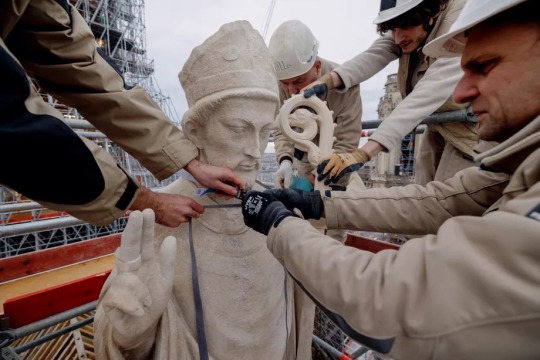
Restoration of the statue of St. Denis: 846 million euros for a pile of old stones? Foto: Patrick Zachmann/Magnum Photos

The nave of the cathedral: the stones are now "blonde" again, brighter and more radiant than ever. Foto: Patrick Zachmann/Magnum Photos
A few meters below, in the new roof truss of the cathedral, it smells of Christmas and fresh oak wood. Here you can see the faithful reconstruction of the medieval roof structure that was destroyed by the fire. It was also made possible because an architecture student had remeasured the roof for a research project in 2015. All the oak trunks used were worked manually with an ax by carpenters who still master the old techniques. Not folklore, as they say, but a method that makes the wood more stable. When worked by hand, it is easier to follow the core of the tree trunk. The beams were then joined together with wooden dowels, as they had been for centuries.
The daffodils are blooming in the garden of the Archbishop of Paris, and church bells can be heard from afar. The Catholic Church is not allowed to levy a church tax in France and is poorer than the German Church, but Monseigneur Laurent Ulrich lives very nicely. At the beginning of the 20th century, a wealthy widow bequeathed her 1,600-square-meter city palace and private chapel in the 7th arrondissement to the diocese of Paris, with the sole condition that the archbishop should live there in future. The property is now estimated to be worth over 50 million euros.
The world's richest man lives next door. He has also been the biggest donor in the effort to restore Notre-Dame. Bernard Arnault, owner of the luxury group Louis Vuitton-Moët Hennessy, gave 200 million for the reconstruction – twice the amount given by his eternal rival, the billionaire and art collector François Pinault.
"France has become a divided country, a fractured society. But Notre Dame has managed to unite our nation for a moment."
— Monseigneur Laurent Ulrich, the Archbishop of Paris
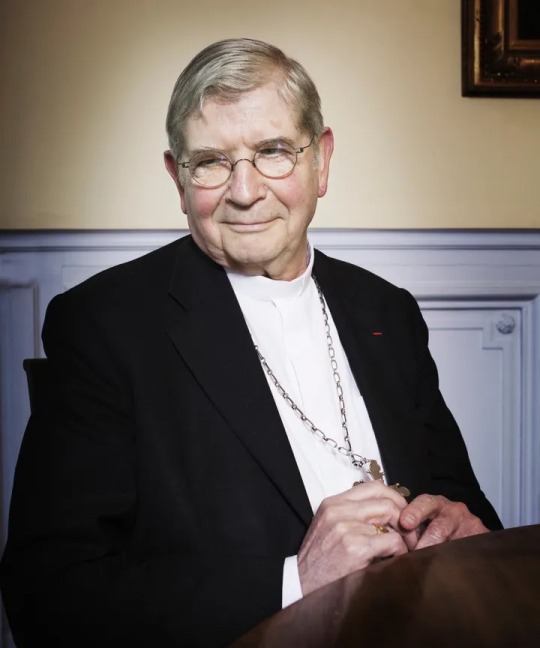
Foto: Sophie Carrère/Der Spiegel
It's raining outside, but Monseigneur is in good spirits on this morning. A few days ago, the topping-out ceremony for the newly constructed roof truss of Notre-Dame took place. In December, Laurent Ulrich consecrated the rooster for the crossing tower, which contains the relics of two saints that survived the night of the fire, a small part of the famous crown of thorns of Jesus Christ and, more recently, a parchment paper with the names of the craftsmen involved in the reconstruction.
If there are no storms or other disasters, he will be able to open Notre-Dame on time by December 8, says Ulrich. The originally planned date of April 15, 2024, had to be canceled due to difficult working conditions during the pandemic and strong winds.
The archbishop says he has been worried in recent years. "France has become a divided country, a fractured society," he says. "But Notre-Dame has managed to unite our nation for a moment. That makes me happy."
Monseigneur Ulrich doesn't want the April 15 fire to be forgotten, even if it was perhaps only caused by a short circuit or another trivial cause. The cause has not yet been determined. The archbishop has issued a call for tenders for six new stained glass windows in the cathedral. They are to be designed by contemporary artists "to leave a trace of the event that deeply wounded Notre-Dame. And which nevertheless showed what we are capable of: We were able to close this wound again." Macron has approved the project.
There are many things that divide the archbishop and the president. Just a few weeks ago, the right to abortion was enshrined in the constitution at Macron's initiative. A draft law on euthanasia is currently being prepared – issues that Monseigneur does not support. But when it comes to Notre-Dame, the two are in agreement. "Next December, the president will give the church back to Catholics to practice their religion. And we will thank him and everyone involved for that."
The faithful, Parisians and tourists will then discover a cathedral that is brighter and more radiant than ever before. After extensive work, the stones and columns inside the nave have been restored to their original color. Restorers painstakingly removed the dirt of past centuries, layer by layer. They are now "blonde" again, as the experts say. This color gives the nave something unusually sculptural. A depth that has been overshadowed by shades of gray for decades.
The colors in the neo-Gothic sacristy, once designed by architect Viollet-le-Duc, are also visible again for the first time. The restorers who cleaned it were amazed at how brightly colored this room once was, how deep blue the ceiling, how pink the frescoes.
Notre-Dame is actually more beautiful than before.
At the very front of the altar is an 18th century Pietà, a depiction of Mary with the body of Jesus Christ taken down from the cross. On the evening of April 15, molten lead had flowed from the roof of the church directly into the open right hand of Jesus, staining the entire sculpture with black splashes. There is no sign of it today. The restorers only left the lead in the palm of the hand. As a reminder of a special moment.
#Rebuilding Notre-Dame#France 🇫🇷#Emmanuel Macron | The War Criminal | The Scrotums Licker of the Zionist 🐖 🐷 🐗 🐖
0 notes